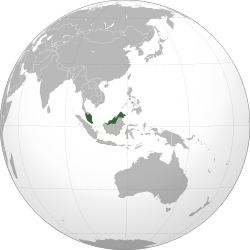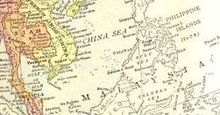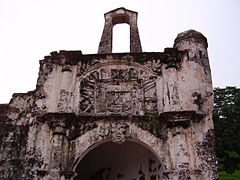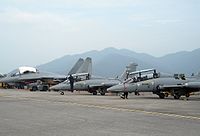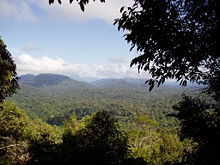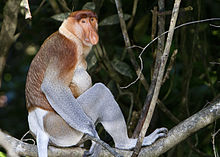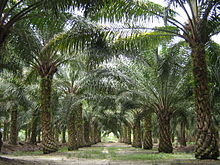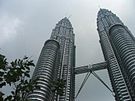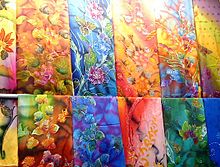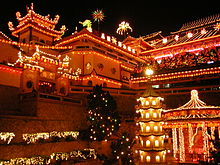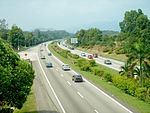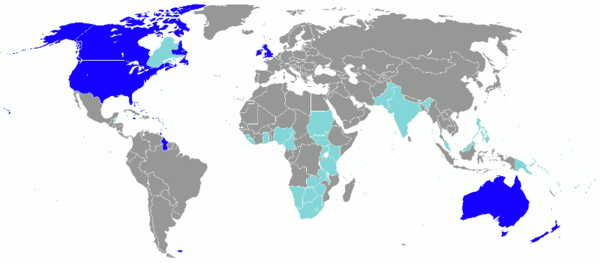- Malaysia
-
Malaysia 

Flag Emblem Motto: "Bersekutu Bertambah Mutu"
"Unity Is Strength" [1]Anthem: Negaraku (My Country) Capital
(and largest city)Kuala Lumpur[a]
Putrajaya (administrative centre)
3°08′N 101°42′E / 3.133°N 101.7°EOfficial language(s) Bahasa Malaysia[b] Official script Latin alphabet[c] Used for some purposes English[d] Ethnic groups 50.4% Malay
23.7% Chinese
11.0% Indigenous
7.1% Indian
7.8% Other[2]Demonym Malaysian[3] Government Federal constitutional elective monarchy and Federal parliamentary democracy - Yang di-Pertuan Agong Mizan Zainal Abidin - Prime Minister Najib Tun Razak - Deputy Prime Minister Muhyiddin Yassin Independence - From the United Kingdom (Malaya only) 31 August 1957[5][6] - Federation of Malaya, Sabah, Sarawak, and Singapore[e][4] 16 September 1963[7] Area - Total 329,847 km2 (67th)
127,355 sq mi- Water (%) 0.3 Population - 2010[8] census 28,334,135 - Density 86/km2 (114th)
216.45/sq miGDP (PPP) 2011 estimate - Total $442.010 billion[9] - Per capita $15,384[9] GDP (nominal) 2011 estimate - Total $247.781 billion[9] - Per capita $8,624[9] Gini (2002[2]) 46.1 (36) HDI (2010)  0.744[10] (high) (57th)
0.744[10] (high) (57th)Currency Ringgit (RM) ( MYR)Time zone MST (UTC+8) - Summer (DST) Not observed (UTC+8) Date formats dd-mm-yyyy Drives on the Left ISO 3166 code MY Internet TLD .my Calling code +60 ^ a. Kuala Lumpur is the capital city and is home to the legislative branch of the Federal government. Putrajaya is the primary seat of the federal government where the executive and judicial branches are located. ^ b. The current terminology as per government policy is Bahasa Malaysia (literally Malaysian language)[11] but legislation continues to refer to the official language as Bahasa Melayu (literally Malay language).
^ c. Under the National Language Act 1967: "The script of the national language shall be the Rumi [Latin] script: provided that this shall not prohibit the use of the Malay script, more commonly known as the Jawi script, of the national language."[12]
^ d. English may be used for some purposes under the National Language Act 1967.
^ e. Singapore became an independent country on 9 August 1965.[13]Malaysia (
 i/məˈleɪʒə/ mə-lay-zhə or
i/məˈleɪʒə/ mə-lay-zhə or  i/məˈleɪsiə/ mə-lay-see-ə) is a federal constitutional monarchy in Southeast Asia. It consists of thirteen states and three federal territories and has a total landmass of 329,847 square kilometres (127,350 sq mi) separated by the South China Sea into two regions, Peninsular Malaysia and Malaysian Borneo. Land borders are shared with Thailand, Indonesia, and Brunei, and maritime borders exist with Singapore, Vietnam, and the Philippines. The capital city is Kuala Lumpur, while Putrajaya is the seat of the federal government. In 2010 the population exceeded 27.5 million.
i/məˈleɪsiə/ mə-lay-see-ə) is a federal constitutional monarchy in Southeast Asia. It consists of thirteen states and three federal territories and has a total landmass of 329,847 square kilometres (127,350 sq mi) separated by the South China Sea into two regions, Peninsular Malaysia and Malaysian Borneo. Land borders are shared with Thailand, Indonesia, and Brunei, and maritime borders exist with Singapore, Vietnam, and the Philippines. The capital city is Kuala Lumpur, while Putrajaya is the seat of the federal government. In 2010 the population exceeded 27.5 million.Malaysia has its origins in the Malay Kingdoms present in the area which, from the 18th century, became subject to the British Empire. The first British territories were known as the Straits Settlements, with the other states forming protectorates. The states on Peninsular Malaysia, then known as Malaya, were first unified as the Malayan Union in 1946. Malaya was restructured as the Federation of Malaya in 1948, and achieved independence on 31 August 1957. Malaya united with Sabah, Sarawak, and Singapore on 16 September 1963, with si being added to give the new country the name Malaysia. However, less than two years later in 1965, Singapore was expelled from the federation. Since independence, Malaysia has had one of the best economic records in Asia, with GDP growing an average 6.5% for almost 50 years. The economy has traditionally been fuelled by its natural resources, but is expanding in the sectors of science, tourism, commerce and medical tourism.
The head of state is the Yang di-Pertuan Agong, an elected monarch chosen from the hereditary rulers of the nine Malay states every five years. The head of government is the Prime Minister. The government system is closely modelled on the Westminster parliamentary system and the legal system is based on English Common Law. The country is multi-ethnic and multi-cultural, factors that influence its culture and play a large role in politics. The secular constitution declared Islam the state religion while protecting freedom of religion.
Malaysia contains the southernmost point of continental Eurasia, Tanjung Piai, and is located near the equator and has a tropical climate. It has a biodiverse range of flora and fauna, and is considered a megadiverse country. It is a founding member of the Association of Southeast Asian Nations and the Organisation of Islamic Cooperation, and a member of Asia-Pacific Economic Cooperation, the Commonwealth of Nations, and the Non-Aligned Movement.
Contents
Etymology
The word Melayu is thought to derive from the Sanskrit term Malaiur or Malayadvipa, which can be translated as "land of mountains", the word used by ancient Indian traders when referring to the Malay Peninsula.[14][15][16][17][18] Other theories propose it originates from the Tamil word Malai, meaning "mountain".[19] The term was later used as the name of the Melayu Kingdom, which existed between the 7th and the 13th centuries on Sumatra.[20]
Following his 1826 expedition in Oceania, French navigator Jules Dumont d'Urville invented the terms Malaysia, Micronesia and Melanesia, distinguishing these Pacific cultures and island groups from the already existing term Polynesia. In 1831, he proposed these terms to the Société de Géographie. Dumont d'Urville described Malaysia as "an area commonly known as the East Indies".[21] In 1850, the English ethnologist George Samuel Windsor Earl, writing in the Journal of the Indian Archipelago and Eastern Asia, proposed naming the islands of Southeast Asia as Melayunesia or Indunesia, favouring the former.[22]
In 1957, the Federation of Malaya was declared as an independent federation of the Malay states on the Malay Peninsula.[23] The name "Malaysia" was adopted in 1963 when the existing states of the Federation of Malaya, plus Singapore, North Borneo and Sarawak formed a new federation,[7] with "si" being added to Malaya in honour of the three joining states.[24] Prior to that, the name itself had been used to refer to the whole Malay Archipelago.[25] Politicians in the Philippines once contemplated naming their state "Malaysia", but in 1963 Malaysia adopted the name first.[26] At the time of the 1963 federation, other names were considered: among them was Langkasuka, after the historic kingdom located at the upper section of the Malay Peninsula in the 1st millennium CE.[27]
History
Evidence of human habitation in Malaysia dates back 40,000 years,[28] with the first inhabitants thought to be Negritos.[29] Traders and settlers from India and China arrived as early as the 1st century AD, establishing trading ports and towns in the 2nd and 3rd centuries. This resulted in strong Indian and Chinese influence on the local cultures, and the people of the Malay Peninsula adopted the religions of Hinduism and Buddhism. Sanskrit inscriptions appear as early as the 4th or 5th century.[30] The Kingdom of Langkasuka arose around the 2nd century in the northern area of the Malay Peninsula, lasting until about the 15th century.[27] Between the 7th and the 13th century, much of the south of the Malay Peninsula was under the Srivijaya empire. After the fall of Srivijaya, the Majapahit empire had influence over most of Peninsular Malaysia and the Malay Archipelago.[31] In the early 15th century, Parameswara, a prince of the former Srivijayan empire, founded the Malacca Sultanate, commonly considered the first independent state in the peninsula.[32] Parameswara became a Muslim, and due to this the conversion of Malays to Islam accelerated in the 15th century.[3] Malacca was an important commercial centre during this time, attracting trade from around the region.[3]
In 1511 Malacca was conquered by Portugal,[3] after which it was taken by the Dutch in 1641.[31] In 1786 the British Empire set foot in Malaya, when the Sultan of Kedah leased Penang to the British East India Company. The British obtained Singapore in 1819,[33] and in 1824 took control of Malacca following the Anglo-Dutch Treaty. By 1826 the British directly controlled Penang, Malacca, Singapore, and the island of Labuan, which they established as the crown colony of the Straits Settlements. By the 20th century, the states of Pahang, Selangor, Perak, and Negeri Sembilan, known together as the Federated Malay States, had British Residents appointed to advise the Malay rulers, to whom the rulers were bound to defer by treaty.[34] The remaining five states in the peninsula, known as the Unfederated Malay States, while not directly under British rule, also accepted British advisers around the turn of the 20th century. Development on the Peninsula and Borneo were generally separate until the 19th century.[31] Sabah was governed as the crown colony of British North Borneo after it was leased from the Sultanate of Sulu in 1878.[35] In 1842, Sarawak was ceded by the Sultan of Brunei to James Brooke, whose successors ruled as the White Rajahs over an independent kingdom until 1946, when it became a British colony.[36]
In the Second World War the Japanese army invaded and subsequently occupied Malaya, Sabah, Sarawak, and Singapore for over three years. During this time, ethnic tensions were raised and nationalism grew.[37] Popular support for independence increased after Malaya was reconquered by Allied Forces.[38] Post-war British plans to unite the administration of Malaya under a single crown colony called the Malayan Union met with strong opposition from the Malays, who opposed the weakening of the Malay rulers and the granting of citizenship to the ethnic Chinese. The Malayan Union, established in 1946 and consisting of all the British possessions in the Malay Peninsula with the exception of Singapore, was quickly dissolved and replaced by the Federation of Malaya, which restored the autonomy of the rulers of the Malay states under British protection.[39] During this time, rebels under the leadership of the Malayan Communist Party launched guerrilla operations designed to force the British out of Malaya. The Malayan Emergency lasted from 1948 to 1960, and involved a long anti-insurgency campaign by Commonwealth troops in Malaya.[40] In 1963 Malaya, along with the then British crown colonies of Sabah, Sarawak, and Singapore, federated to form Malaysia. The proposed date of federation was 31 August 1963, however, the date was delayed until 16 September 1963 due to opposition from Indonesia's Sukarno and the Sarawak United Peoples' Party.[41]
Independence brought heightened tensions including a conflict with Indonesia over the formation of Malaysia, Singapore's eventual exit in 1965,[42][43] and racial strife which caused the 13 May race riots in 1969.[44] After the riots, the controversial New Economic Policy was launched by Prime Minister Tun Abdul Razak, trying to increase the share of the economy held by the bumiputra. The country has since maintained a delicate ethno-political balance, with a system of government that has attempted to combine overall economic development with political and economic policies that promote equitable participation of all races.[45]
Under Prime Minister Mahathir bin Mohamad there was a period of rapid economic growth and urbanisation beginning in the 1980s. This period saw a shift from an agriculture-based economy to one based on manufacturing and industry. The physical landscape of the country changed with the emergence of numerous mega-projects, such as the Petronas Towers, the North-South Expressway, the Multimedia Super Corridor, and the new federal administrative capital of Putrajaya.[24] In the late 1990s, the Asian financial crisis almost caused the collapse of the currency and the stock and property markets.[46] Political unrest was caused by the dismissal of the deputy prime minister Dato' Seri Anwar Ibrahim.[47] In November 2007 two anti-government rallies occurred, precipitated by allegations of corruption and discrepancies in the election system that heavily favoured the ruling political party, National Front, which had been in power since Malaya achieved independence.[48]
Governance
Malaysia is a federal constitutional elective monarchy. The system of government is closely modelled on that of the Westminster parliamentary system, a legacy of British colonial rule.[49] The head of state is the Yang di-Pertuan Agong, commonly referred to as the king. The Yang di-Pertuan Agong is elected to a five-year term by and from among the nine hereditary rulers of the Malay states; the other four states, which have titular Governors, do not participate in the selection. By informal agreement the position is systematically rotated among the nine,[49] and has been held by Mizan Zainal Abidin of Terengganu since 2007.[50] The Yang di-Pertuan Agong's role has been mostly ceremonial since changes to the constitution in 1994.[51]
Legislative power is divided between federal and state legislatures. The bicameral federal parliament consists of the lower house, the House of Representatives and the upper house, the Senate.[52] The 222-member House of Representatives is elected for a maximum term of five years from single-member constituencies, which are determined based on population. All 70 senators sit for three-year terms; 26 are elected by the 13 state assemblies, and the remaining 44 are appointed by the Yang di-Pertuan Agong upon the Prime Minister's recommendation.[3] The parliament follows a multi-party system and the government is elected through a first-past-the-post system. Since independence Malaysia has been governed by a multi-party coalition known as the Barisan Nasional.[3]
Each state has a unicameral State Legislative Assembly whose members are elected from single-member constituencies. State governments are led by Chief Ministers,[3] who are state assembly members from the majority party in the assembly. In each of the states with a hereditary ruler, the Chief Minister is required to be a Malay, appointed by the ruler upon the recommendation of the Prime Minister.[53] Parliamentary elections are held at least once every five years, the most recent of which took place in March 2008.[3] Registered voters of age 21 and above may vote for the members of the House of Representatives and, in most of the states, for the state legislative chamber. Voting is not mandatory.[54] Except for elections in Sarawak, all state elections are held concurrently with the federal election.[51]
Executive power is vested in the Cabinet, led by the Prime Minister. The prime minister must be a member of the house of representatives, in the opinion of the Yang di-Pertuan Agong, commands a majority in parliament. The cabinet is chosen from members of both houses of Parliament.[3] The Prime Minister is both the head of cabinet and the head of government.[51] The incumbent, Najib Razak, appointed in 2009, and is the sixth prime minister since independence.[55]
Malaysia's legal system is based on English Common Law.[3] Although the judiciary is theoretically independent, supporters of the government hold many judicial positions.[56] The highest court in the judicial system is the Federal Court, followed by the Court of Appeal and two high courts, one for Peninsular Malaysia and one for East Malaysia. Malaysia also has a special court to hear cases brought by or against Royalty.[57] Separate from the civil courts are the Syariah Courts, which decide on cases which involve Malaysian Muslims[58] and run parallel to the normal court system.[59] The Internal Security Act allows detention without trial, and the death penalty is in use for crimes such as drug trafficking.[60]
Race is a significant force in politics, and many of the political parties are ethnically based.[3] Actions such as the New Economic Policy[45] and the National Development Policy which superseded it, were implemented to advance the standing of the bumiputra, who are considered the original inhabitants of Malaysia, over non-bumiputra such as Malaysian Chinese and Malaysian Indians.[61] These policies provide preferential treatment to Malays over non-Malays in employment, education, scholarships, business, and access to cheaper housing and assisted savings. However, it has generated greater interethnic resentment.[62] Debate exists over whether the country should be secular or Islamic.[63] Some state governments controlled by the Pan-Malaysian Islamic Party, including that of Terengganu, have passed Islamic laws, but these have not gone into effect due to opposition from the federal government.[64]
Foreign relations and military
Malaysia's foreign policy is officially based on the principle of neutrality and maintaining peaceful relations with all countries, regardless of their political system. It seeks to further develop relations with other countries in the region and portray itself as a progressive Islamic nation.[65] The government attaches a high priority to the security and stability of Southeast Asia, and has tried to strengthen relations with other Islamic states.[66] A strong tenet of Malaysia's policy is national sovereignty and the right of a country to control its domestic affairs.[51]
A founding member of the Association of Southeast Asian Nations (ASEAN)[67] and the Organisation of the Islamic Conference (OIC, now the Organisation of Islamic Cooperation),[68] the country participates in many international organisations such as the United Nations,[69] the Asia-Pacific Economic Cooperation,[70] the Developing 8 Countries,[71] and the Non-Aligned Movement (NAM).[72] It has chaired ASEAN, the OIC, and the NAM in the past.[3] A former British colony, it is also a member of the Commonwealth of Nations.[73] Kuala Lumpur was the site of the first East Asia Summit in 2005.[66]
The policy towards territorial disputes by the government is one of pragmatism, with the government solving disputes in a number of ways, such as bringing the case to the International Court of Justice.[74] The Spratly Islands are disputed by many states in the area, although tensions have eased since the 2002 Declaration on the Conduct of Parties in the South China Sea. Brunei and Malaysia in 2008 announced an end to claims of each other's land, and to resolve issues related to their maritime borders. The Philippines has a dormant claim to Sabah. Singapore's land reclamation has caused tensions, and maritime border disputes exist with Indonesia.[75]
Malaysia has never recognised Israel and has no diplomatic ties with it.[76] It has remained a strong supporter of the State of Palestine,[77] and has called for Israel to be taken to the International Criminal Court over the Gaza flotilla raid.[78] Malaysian peacekeeping forces are present in Lebanon[79] and have contributed to many other UN peacekeeping missions.[3]
Malaysian defence requirements are assigned to the Malaysian Armed Forces (Angkatan Tentera Malaysia – ATM). The armed forces has three branches, the Royal Malaysian Navy (Tentera Laut Diraja Malaysia – TLDM), the Malaysian Army (Tentera Darat Malaysia – TD), and the Royal Malaysian Air Force (Tentera Udara Diraja Malaysia – TUDM). There is no conscription, and the required age for voluntary military service is 18. The military uses 1.9 per cent of the country's GDP, and hires 1.23 per cent of Malaysia's manpower.[80]
The Five Power Defence Arrangements is a regional security initiative which has been in place for almost 40 years. It involves joint military exercises held among Malaysia, Singapore, Australia, New Zealand, and the United Kingdom.[81] Joint exercises and war games have been held with Indonesia for years.[82] Malaysia and the Philippines have agreed to host joint security force exercises in order to secure their maritime border and tackle issues such as illegal immigration.[83] There are fears that unrest in the Muslim areas of the southern Philippines[84] and southern Thailand[85] could spill over into Malaysia.
Subdivisions
Malaysia is made up of 13 states and three federal territories. These are divided between two regions, with 11 states and two federal territories on Peninsular Malaysia and the other two states and one federal territory in East Malaysia. As Malaysia is a federation, the governance of the states is divided between the federal and the state governments, while the Federal government has direct administration of the federal territories.[86]
The 13 states are based on historical Malay Kingdoms, and 9 of the 11 Peninsular states, known as the Malay states, retain their royal families. The Yang di-Pertuan Agong is elected by and from the nine rulers to serve a five-year term.[3] Each state has a unicameral legislature known as the State Legislative Assembly. The states of East Malaysia (Sabah and Sarawak) have separate immigration policies and controls, and a unique residency status.[87] For citizens of one of these states or Peninsular Malaysia, the other areas of Malaysia are considered foreign countries under immigration laws.[88] Each state is further divided into districts, which are then divided into mukim. In Sabah and Sarawak districts are grouped into "Divisions".[89]
The federal parliament is permitted to legislate on issues of land, the Islamic religion and local government, in order to provide for a uniform law among different states, or on the request of the state assembly concerned. The law in question must also be passed by the state assembly as well, except in the case of certain land law-related subjects. Non-Islamic issues that fall under the purview of the state may also be legislated at the federal level for the purpose of conforming with Malaysian treaty obligations.[90]
Geography
Malaysia is the 66th largest country by total land area, with a land area of 329,847 square kilometres (127,355 sq mi). It has land borders with Thailand in West Malaysia, and Indonesia and Brunei in East Malaysia.[2] It is linked to Singapore by a narrow causeway, and also has maritime boundaries with Vietnam[91] and the Philippines.[92] The land borders are defined in large part by geological features such as the Perlis River, Golok River and the Pagalayan Canal, whilst some of the maritime boundaries are the subject of ongoing contention.[2] Brunei forms what is almost an enclave in Malaysia,[93] with the state of Sarawak dividing it into two parts. Malaysia is the only country with territory on both the Asian mainland and the Malay archipelago,[94] and Tanjung Piai, located in the southern state of Johor, is the southernmost tip of continental Asia.[95] The Strait of Malacca, lying between Sumatra and Peninsular Malaysia, is one of the most important thoroughfares in global commerce, carrying 40 per cent of the world's trade.[96]
The two parts of Malaysia, separated from each other by the South China Sea, share a largely similar landscape in that both West (Peninsula) and East Malaysia feature coastal plains rising to hills and mountains.[2] Peninsular Malaysia, containing 40 per cent of Malaysia's land area,[94] extends 740 kilometres (460 mi) from north to south, and its maximum width is 322 kilometres (200 mi).[97] It is divided between its east and west coasts by the Titiwangsa Mountains,[98] part of a series of mountain ranges running down the centre of the peninsula.[94] These mountains are heavily forested,[99] and mainly composed of granite and other igneous rocks. Much of it has been eroded, creating a karst landscape.[94] The range is the origin of some of Peninsular Malaysia's river systems.[99] The coastal plains surrounding the peninsula reach a maximum width of 50 kilometres (31 mi), and the peninsula's coastline is nearly 1,931 kilometres (1,200 mi) long, although harbours are only available on the western side.[97]
East Malaysia, on the island of Borneo, has a coastline of 2,607 kilometres (1,620 mi).[2] It is divided between coastal regions, hills and valleys, and a mountainous interior.[94] The Crocker Range extends northwards from Sarawak,[94] dividing the state of Sabah. It is the location of Mount Kinabalu.[100] Mount Kinabalu, at 4,095.2 metres (13,436 ft), is the tallest mountain in Malaysia and is protected as Kinabalu National Park, a UNESCO World Heritage Site.[101] The highest mountain ranges form the border between Malaysia and Indonesia. Sarawak contains the Mulu Caves, the largest cave system in the world.[94]
Around these two halves of Malaysia are numerous islands, the largest of which is Labuan.[102] The local climate is equatorial and characterised by the annual southwest (April to October) and northeast (October to February) monsoons.[97] The temperature is moderated by the presence of the surrounding oceans.[94] Humidity is usually high, and the average annual rainfall is 250 centimetres (98 in).[97] The climates of the Peninsula and the East differ, as the climate on the peninsula is directly affected by wind from the mainland, as opposed to the more maritime weather of the East. Local climates can be divided into three regions, highland, lowland, and coastal. Climate change is likely to affect sea levels and rainfall, increasing flood risks and leading to droughts.[94]
Biodiversity
Malaysia is a megadiverse country with a high number of species and high levels of endemism.[103] It is estimated to contain 20 per cent of the world's animal species.[104] There are about 210 mammal species in the country.[105] High levels of endemism are found on the diverse forests of Borneo's mountains, as species are isolated from each other by lowland forest.[94] Over 620 species of birds have been recorded in Peninsular Malaysia,[104] with many endemic to the mountains there. A high number of endemic bird species are also found in Malaysian Borneo.[94] 250 reptile species have been recorded in the country, with about 150 species of snakes[106] and 80 species of lizards.[105] There are about 150 species of frogs,[105] and thousands of insect species.[105] Malaysia's exclusive economic zone is 1.5 times larger than its land area,[107] and some of its waters are in the Coral Triangle, a biodiversity hotspot.[108] The waters around Sipadan island are the most biodiverse in the world.[104] Bordering East Malaysia, the Sulu Sea is a biodiversity hotspot, with around 600 coral species and 1200 fish species.[109]
About two thirds of Malaysia is covered in forest,[97] with some forests believed to be 130 million years old.[105] It is composed of a variety of types, although they are mainly dipterocarp forests.[110] Lowland forest occurs below 760 metres (2,493 ft),[97] and formerly East Malaysia was covered in such rainforest,[110] which is supported by its hot wet climate.[94] There are around 14,500 species of flowering plants and trees.[105] Besides rainforests, there are over 1,425 square kilometres (550 sq mi) of mangroves in Malaysia,[97] and a large amount of peat forest. At higher altitudes, oaks, chestnuts, and rhododendrons replace dipterocarps.[94] There are an estimated 8,500 species of vascular plants in Peninsular Malaysia, with another 15,000 in the East.[111] The forests of East Malaysia are estimated to be the habitat of around 2,000 tree species, and are one of the most biodiverse areas in the world, with 240 different species of trees every hectare.[94] These forests host many members of the Rafflesia genus, the largest flowers in the world,[110] with a maximum diameter of 1 metre (3 ft).[105]
 Some species of Rafflesia can grow up to 1 metre (3 ft) in diameter, making them the largest flowers in the world.
Some species of Rafflesia can grow up to 1 metre (3 ft) in diameter, making them the largest flowers in the world.
Logging, along with cultivation practices has devastated tree cover, causing severe environmental degradation in the country. Over 80 per cent of Sarawak's rainforest has been cleared.[94] Floods in East Malaysia have been worsened by the loss of trees, and over 60 per cent of the Peninsular's forest have been cleared.[105] With current rates of deforestation, the forests are predicted to be extinct by 2020.[94] Deforestation is a major problem for fauna, as the forest is cut to make room for plantations.[112] Most remaining forest is found inside national parks.[105] Habitat destruction has proved a threat for marine life.[109] Illegal fishing is another major threat,[109] with fishing methods such as dynamite fishing and poisoning depleting marine ecosystems.[113] Leatherback turtle numbers have dropped 98 per cent since the 1950s.[106] Hunting has also been an issue for some animals,[105] with overconsumption and the use of animal parts for profit endangering many animals, from marine life[109] to tigers.[112] Marine life is also detrimentally affected by uncontrolled tourism.[114]
The Malaysian government aims to balance economic growth with environmental protection, but has been accused of favouring big business over the environment.[105] Some state governments are now trying to counter the environmental impact and pollution created by deforestation;[110] and the federal government is trying to cut logging by 10 per cent each year. 28 national parks have been established; 23 in East Malaysia and seven in the Peninsular.[105] Tourism has been limited in biodiverse areas such as Sipadan island.[114] Animal trafficking is a large issue, and the Malaysian government is holding talks with the governments of Brunei and Indonesia to standardise anti-trafficking laws.[115]
Economy
Malaysia is a relatively open state-oriented and newly industrialised market economy.[116][117] The state plays a significant but declining role in guiding economic activity through macroeconomic plans. Malaysia has had one of the best economic records in Asia, with GDP growing an average 6.5 per cent annually from 1957 to 2005.[3] In 2010 the GDP per capita (PPP) was $414.400; billion, the 3rd largest economy in ASEAN and 29th largest economy in the world.[118]
In the 1970s, the predominantly mining and agricultural-based Malaysian economy began a transition towards a more multi-sector economy. Since the 1980s the industrial sector has led Malaysia's growth.[119] High levels of investment played a significant role in this.[3] The Malaysian economy recovered from the 1997 Asian Financial Crisis sooner than neighbouring countries, and has since recovered to the levels of the pre-crisis era with a GDP per capita of $14,800.[120][121] Inequalities exist between different ethnic groups, with a major issue being that the Chinese minority accounts for 70 per cent of the country's market capitalisation, even though it only makes up about one-third of it.[122]
International trade, facilitated by the adjacent Strait of Malacca shipping route, and manufacturing are key sectors of the country's economy.[123][124][125] Malaysia is an exporter of natural and agricultural resources, the most valuable exported resource being petroleum.[3] At one time, it was the largest producer of tin,[126] rubber and palm oil in the world. Manufacturing has a large influence in the country's economy,[127] although Malaysia’s economic structure has been moving away from it.[128]
In an effort to diversify the economy and make Malaysia’s economy less dependent on exported goods, the government has pushed to increase tourism in Malaysia. As a result, tourism has become Malaysia’s third largest source of income from foreign exchange, although it is threatened by the negative effects of the growing industrial economy, with large amounts of air and water pollution along with deforestation affecting tourism.[130] The country has developed into a centre of Islamic banking, and is the country with the highest numbers of female workers in that industry.[131] Knowledge-based services are also expanding.[128]
Science policies in Malaysia are regulated by the Ministry of Science, Technology, and Innovation. The country is one of the world's largest exporters of semiconductor devices, electrical goods, and information and communication technology products.[3] Malaysia began developing its own its own space programme in 2002,[132][133] and in 2006 Russia agreed to transport one Malaysian to the International Space Station as part of a multi-billion dollar purchase of 18 Russian Sukhoi Su-30MKM fighter jets by the Royal Malaysian Air Force.[134] In an effort to create a self-reliant defensive ability and support national development, Malaysia privatised some of its military facilities in the 1970s. This has created a defence industry, which in 1999 was brought under the Malaysia Defence Industry Council. The government continues to try and promote this sector and its competitiveness, actively marketing the defence industry.[135]
Demographics
As of the 2010 census, the population of Malaysia was 28,334,135,[8] making it the 43rd most populated country. The population of Malaysia consists of many ethnic groups. Malays make up 50.4 per cent of the population, while other bumiputra make up another 11 per cent.[2] According to constitutional definition, Malays are Muslims who practice Malay customs and culture. They play a dominant role politically. Bumiputra status is also accorded to certain non-Malay indigenous peoples, including ethnic Thais, Khmers, Chams and the natives of Sabah and Sarawak. Non-Malay bumiputra make up more than half of Sarawak's population and over two thirds of Sabah's population.[2] There also exist aboriginal groups in much smaller numbers on the peninsula, where they are collectively known as Orang Asli.[136] Laws over who gets bumiputra status vary between states.[137]
Other minorities who lack bumiputra status make up a large amount of the population. 23.7 per cent of the population are of Chinese descent, while those of Indian descent comprise 7.1 per cent of the population.[2] The Chinese have historically been dominant in the business and commerce community, and form the majority of the population of Penang. Indians began migrating to Malaysia in the early 19th century.[138] The majority of the Indian community are Tamils.[139]
Malaysian citizenship is not automatically granted to those born in Malaysia, but is granted to a child born of two Malaysian parents outside Malaysia. Dual citizenship is not permitted.[140] Citizenship in the states of Sabah and Sarawak in Malaysian Borneo are distinct from citizenship in Peninsular Malaysia for immigration purposes. Every citizen is issued a biometric smart chip identity card known as MyKad at the age of 12, and must carry the card at all times.[141]
The education system features a non-compulsory kindergarten education followed by six years of compulsory primary education,[3] and five years of optional secondary education.[142] Schools in the primary education system are divided into two categories: national primary schools, which teach in Malay, and vernacular schools, which teach in Chinese or Tamil.[143] Secondary education is conducted for five years. In the final year of secondary education, students sit for the Malaysian Certificate of Education examination.[144] Since the introduction of the matriculation programme in 1999, students who completed the 12-month programme in matriculation colleges can enroll in local universities. However, in the matriculation system, only 10 per cent of places are open to non-bumiputra students.[145]
The infant mortality rate in 2009 was 6 deaths per 1000 births, and life expectancy at birth in 2009 was 75 years.[146] With the aim of developing Malaysia into a medical tourism destination, 5 per cent of the government social sector development budget is spent on health care.[147] The population distribution between the two halves of the country is highly uneven. It is concentrated on Peninsular Malaysia[148] where 20 million of approximately 28 million Malaysians live.[3] 70 per cent of the population is urban.[2] Kuala Lumpur is the capital[2] and the largest city in Malaysia,[149] as well as its main commercial and financial centre.[150] Putrajaya is the seat of government,[151] as many executive and judicial branches of the federal government were moved there to ease growing congestion within Kuala Lumpur.[152]
Due to the rise in labour intensive industries,[153] the country is estimated to have over 3 million migrant workers; about 10 per cent of the population.[154] Sabah-based NGOs estimate that out of the 3 million that make up the population of Sabah, 2 million are illegal immigrants.[155] Malaysia hosts a population of refugees and asylum seekers numbering approximately 171,500. Of this population, approximately 79,000 are from Burma, 72,400 from the Philippines, and 17,700 from Indonesia. Malaysian officials are reported to have turned deportees directly over to human smugglers in 2007, and Malaysia employs RELA, a volunteer militia with a history of controversies, to enforce its immigration law.[156]
Largest cities of Malaysia
The World Gazetteer[157]Rank City Name State Pop. Rank City Name State Pop. 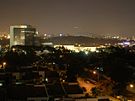
Subang Jaya
1 Subang Jaya Selangor 1 553 589 11 Cheras Selangor 601 534 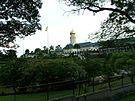
Klang
2 Kuala Lumpur Wilayah Persekutuan 1 435 337 12 Sandakan Sabah 501 195 3 Klang Selangor 1 113 851 13 Kajang Selangor 448 243 4 Johor Bahru Johor 916 409 14 Seremban Negeri Sembilan 439 296 5 Ampang Jaya Selangor 804 901 15 Kuantan Pahang 422 020 6 Ipoh Perak 704 572 16 Tawau Sabah 381 736 7 Shah Alam Selangor 671 282 17 Kuala Terengganu Terengganu 286 317 8 Kuching Sarawak 658 549 18 Miri Sarawak 280 518 9 Petaling Jaya Selangor 638 516 19 Kota Bharu Kelantan 272 647 10 Kota Kinabalu Sabah 604 078 20 Selayang Baru Selangor 265 297 Religion
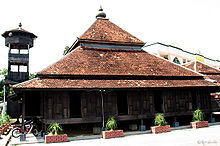 Kampung Laut Mosque in Kota Bharu is one of the oldest mosques in Malaysia, dating to early 18th century.
Kampung Laut Mosque in Kota Bharu is one of the oldest mosques in Malaysia, dating to early 18th century.
The Malaysian constitution guarantees freedom of religion while making Islam the state religion.[158] According to the Population and Housing Census 2010 figures, ethnicity and religious beliefs correlate highly. Approximately 61.3% of the population are practicing Islam. 19.8% Buddhism; 9.2% Christianity; 6.3% Hinduism; and 1.3% practice Confucianism, Taoism and other traditional Chinese religions.[8], 0.7% declared no religion and the remaining 1.4% practised other religions or did not provide any information.[8]
All ethnic Malays are considered Muslim by law of the Constitution.[158] Statistics from the 2010 Census indicate that 83.6% of the Chinese population identify as Buddhist, with significant numbers of adherents following Taoism (3.4%) and Christianity (11.1%), along with small Hui-Muslim populations in areas like Penang.The majority of the Indian population follow Hinduism (86.2%), with a significant minority identifying as Christians (6.0%), Muslims (4.1%). Christianity is the predominant religion of the non-Malay bumiputra community (46.5%) with an additional 40.4% identifying as Muslims.[159]
Muslims are obliged to follow the decisions of Syariah courts in matters concerning their religion. The Islamic judges are expected to follow the Shafi`i legal school of Islam, which is the main madh'hab of Malaysia.[160] The jurisdiction of Shariah courts is limited only to Muslims in matters such as marriage, inheritance, divorce, apostasy, religious conversion, and custody among others. No other criminal or civil offences are under the jurisdiction of the Shariah courts, which have a similar hierarchy to the Civil Courts. Despite being the supreme courts of the land, the Civil Courts (including the Federal Court) do not hear matters related to Islamic practices.[161]
Language
The official language of Malaysia is Bahasa Malaysia,[2] a standardised form of the Malay language.[162] Historically English was the de facto administrative language, with Malay becoming predominant after the 1969 race riots.[163] English remains an active second language, and serves as the medium of instruction for maths and sciences in all public schools.[164][165] Malaysian English, also known as Malaysian Standard English (MySE), is a form of English derived from British English. Malaysian English sees wide use in business, along with Manglish, which is a colloquial form of English with heavy Malay, Chinese, and Tamil influences. The government discourages the misuse of Malay and has instituted fines for public signs that mix Malay and English.[166][167]
Many other languages are used in Malaysia, which contains speakers of 137 living languages.[168] Peninsular Malaysia contains speakers of 41 of these languages.[169] The native tribes of East Malaysia have their own languages which are related to, but easily distinguishable from, Malay. The Iban is the main tribal language in Sarawak while Dusunic languages are spoken by the natives in Sabah.[170] Chinese Malaysians predominately speak Chinese dialects from the southern provinces of China. The more common dialects in the country are Cantonese, Mandarin, Hokkien, Hakka, Hainanese, and Fuzhou. Tamil is used predominantly by Tamils, who form a majority of Malaysian Indians. Other south Asian languages are also widely spoken in Malaysia, as well as Thai[2] A small number of Malaysians have Caucasian ancestry and speak creole languages, such as the Portuguese based Malaccan Creoles,[171] and the Spanish based Chavacano language.[172]
Culture
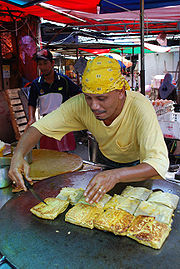 A cook making murtabak, a type of pancake mixed with eggs, small pieces of meat and onions, in Kuala Lumpur.
A cook making murtabak, a type of pancake mixed with eggs, small pieces of meat and onions, in Kuala Lumpur.
Malaysia is a multi-ethnic, multicultural and multilingual society. The original culture of the area stemmed from indigenous tribes that lived there, along with the Malays who later moved there. Substantial influence exists from Chinese and Indian culture, dating back to when foreign trade began in the area. Other cultures that heavily influenced the culture of Malaysia include Persian, Arabic, and British culture. Due to the political structure of the government, coupled with the social contract theory, there has been minimal cultural assimilation of ethnic minorities.[173]
In 1971, the government created a "National Cultural Policy". This policy defined Malaysian culture, stating that it must be based on the culture of the indigenous peoples of Malaysia, it may incorporate suitable elements from other cultures, and that Islam must play a part in Malaysian culture.[174] It also promoted the Malay language above others.[175] This government intervention into culture has caused resentment among non-Malays who feel their cultural freedom was lessened. Both Chinese and Indian associations have submitted memorandums to the government, accusing it of formulating an undemocratic culture policy.[174]
Some cultural disputes exist between Malaysia and neighbouring countries, notably Indonesia. The two countries share a similar cultural heritage, sharing many traditions and items. However, disputes have arisen over things ranging from culinary dishes to Malaysia's national anthem. Strong feelings exist in Indonesia about protecting their national heritage.[176] The Malaysian government and the Indonesian government have met to defuse some of the tensions resulting from the overlaps in culture.[177] Feelings are not as strong in Malaysia, where most recognise that many cultural values are shared.[176]
Fine arts
Traditional Malaysian art was mainly centred around the areas of carving, weaving, and silversmithing.[178] Traditional art ranges from handwoven baskets from rural areas to the silverwork of the Malay courts. Common artworks included ornamental kris, beetle nut sets, and woven batik and songket fabrics. Indigenous East Malaysians are known for their wooden masks.[94] Each ethnic group have distinct performing arts, with little overlap between them. However, Malay art does show some North Indian influence due to the historical influence of India.[179]
Traditional Malay music and performing arts appear to have originated in the Kelantan-Pattani region with influences from India, China, Thailand and Indonesia. The music is based around percussion instruments,[179] the most important of which is the gendang (drum). There are at least 14 types of traditional drums.[180] Drums and other traditional percussion instruments and are often made from natural materials.[180] Music is traditionally used for storytelling, celebrating life-cycle events, and occasions such as a harvest.[179] It was once used as a form of long-distance communication.[180] In East Malaysia, gong-based musical ensemble such as agung and kulintang are commonly used in ceremonies such as funerals and weddings.[181] These ensembles are also common in neighbouring regions such as in the southern Philippines, Kalimantan in Indonesia, and Brunei.[181] Johor state on the south of Peninsular Malaysia has an apparent Arab and Persian influence in art performances like Zapin and Hamdolok, musical instruments like Gambus and Samrah.[182]
Malaysia has a strong oral tradition that has existed since before the arrival of writing, and continues today. Each of the Malay Sultanates created their own literary tradition, influenced by pre-existing oral stories and by the stories that came with Islam.[183] The first Malay literature was in the Arabic script. The earliest known Malay writing is on the Terengganu stone, made in 1303.[94] Chinese and Indian literature became common as the numbers of speakers increased in Malaysia, and locally produced works based in languages from those areas began to be produced in the 19th century.[183] English has also become a common literary language.[94] In 1971, the government took the step of defining the literature of different languages. Literature written in Malay was called "the national literature of Malaysia", literature in other bumiputra languages was called "regional literature", while literature in other languages was called "sectional literature".[175] Malay poetry is highly developed, and uses many forms. The Hikayat form is popular, and the pantun has spread from Malay to other languages.[183]
Cuisine
(clockwise from bottom left): beef soup, ketupat (compressed rice cubes), beef rendang and sayur lodeh
Malaysia's cuisine reflects the multi-ethnic makeup of its population.[184] Many cultures from within the country and from surrounding regions have greatly influenced the cuisine. Much of the influence comes from the Malay, Chinese, Indian, Thai, Javanese, and Sumatran cultures,[94] largely due to the country being part of the ancient spice route.[185] The cuisine is very similar to that of Singapore and Brunei,[105] and also bears resemblance to Filipino cuisine.[94] The different states have varied dishes,[105] and often the food in Malaysia is different from the original dishes.[139]
Sometimes food not found in its original culture is assimilated into another; for example, Chinese restaurants in Malaysia often serve Malay dishes.[186] Food from one culture is sometimes also cooked using styles taken from another culture,[105] This means that although much of Malaysian food can be traced back to a certain culture, they have their own identity.[185] Rice is popular in many dishes. Chili is commonly found in local cuisine, although this does not necessarily make them spicy.[184]
Holidays and festivals
South-East Asia's Largest Temple- Kek Lok Si in Penang being illuminated in preparation for the Lunar New Year.
Malaysians observe a number of holidays and festivities throughout the year. Some are federally gazetted public holidays and some are observed by individual states. Other festivals are observed by particular ethnic or religion groups, and the main holiday of each major group have been declared a public holiday. The most observed national holiday is Hari Merdeka (Independence Day) on 31 August, commemorating the independence of the Federation of Malaya in 1957.[94] Malaysia Day on 16 September commemorates federation in 1963.[187] Other notable national holidays are Labour Day (1 May), and the King's birthday (first week of June).[94]
Muslim holidays are prominent as Islam is the state religion; Hari Raya Puasa (also called Hari Raya Aidilfitri, Malay for Eid al-Fitr), Hari Raya Haji (also called Hari Raya Aidiladha, the translation of Eid ul-Adha), Maulidur Rasul (birthday of the Prophet), and others being observed.[94] Malaysian Chinese celebrate festivals such as Chinese New Year and others relating to traditional Chinese beliefs. Hindus in Malaysia celebrate Deepavali, the festival of lights,[158] while Thaipusam is a religious rite which sees pilgrims from all over the country converge at the Batu Caves.[188] Malaysia's Christian community celebrates most of the holidays observed by Christians elsewhere, most notably Christmas and Easter. East Malaysians also celebrate a harvest festival known as Gawai.[189] Despite most of the festivals being identified with a particular ethnic or religious group, celebrations are participated by all Malaysians in a custom known as "open house".[190]
Sports
Main article: Sport in MalaysiaPopular sports in Malaysia include soccer, badminton, field hockey, bowling, tennis, squash, martial arts, horse riding, sailing, and skate boarding.[190] Badminton matches attract thousands of spectators, and Malaysia, along with Indonesia and China, has consistently held the Thomas Cup since 1948.[191] The Malaysian Lawn Bowl's Federation (PLBM) was registered in 1997.[192] Squash was brought to the country by members of the British army, with the first competition being held in 1939. The Squash Racquets Association of Malaysia was created on 25 June 1972.[193] Malaysia has proposed a Southeast Asian football league.[194] The men's national field hockey team ranked 15th in the world as of August 2010.[195] The 3rd Hockey World Cup was hosted at Merdeka Stadium in Kuala Lumpur, as well as the 10th cup.[196] The country also has its own Formula One track–the Sepang International Circuit. It runs for 310.408 kilometres (192.88 mi), and held its first Grand Prix in 1999.[197]
The Federation of Malaya Olympic Council was formed in 1953, and received recognition by the IOC in 1954. It first participated in the 1956 Melbourne Olympic Games. The council was renamed the Olympic Council of Malaysia in 1964, and has participated in all but one Olympic games since its inception. The largest number of athletes ever sent to the Olympics was 57 to the 1972 Munich Olympic Games.[198] Malaysian athletes have won a total of four Olympic medals, all of which are in badminton.[199] The country has competed at the Commonwealth Games since 1950 as Malaya, and 1966 as Malaysia, and the games were hosted in Kuala Lumpur in 1998.[200][201]
Media
Malaysia's main newspapers are owned by the government and political parties in the ruling coalition,[202] although some major opposition parties also have their own.[203] A divide exists between the media in the two halves of the country. Peninsular-based media gives low priority to news from the East, and often treats the eastern states as colonies of the Peninsula.[204] The media has been blamed for increasing tension between Indonesia and Malaysia, and giving Malaysians a bad image of Indonesians.[205] Besides Malay newspapers, there are large circulation of English, Chinese, and Tamil dailies in the country.[204]
There is very little freedom of the press, leading to very little government accountability.[206] The government has previously tried to crack down on opposition papers before elections when they were unsure of their political situation.[203] In 2007, a government agency issued a directive to all private television and radio stations to refrain from broadcasting speeches made by opposition leaders,[207] a move condemned by politicians from the opposition Democratic Action Party.[208] Sabah, where only one tabloid is not independent of government control, has the freest press in Malaysia.[204] Legislation such as the Printing Presses and Publications Act have also been cited as curtailing freedom of expression.[209]
Infrastructure
The infrastructure of Malaysia is one of the most developed in Asia.[210] Its telecommunications network is second only to Singapore's in Southeast Asia, with 4.7 million fixed-line subscribers and more than 30 million cellular subscribers[211][212] The country has seven international ports, the major one being the Port Klang. There are 200 industrial parks along with specialised parks such as Technology Park Malaysia and Kulim Hi-Tech Park.[190] Fresh water is available to over 95 per cent of the population. During the colonial period, development was mainly concentrated in economically powerful cities and in areas forming security concerns. Although rural areas have been the focus of great development, they still lag behind areas such as the West Coast of Peninsular Malaysia.[213] The telecommunication network, although strong in urban areas, is less available to the rural population.[211]
Malaysia's road network covers 98,721 kilometres (61,342 mi) and includes 1,821 kilometres (1,132 mi) of expressways.[2] The longest highway of the country, the North-South Expressway, extends over 800 kilometres (497 mi) between the Thai border and Singapore. The road systems in Sabah and Sarawak are less developed and of lower quality in comparison to that of Peninsular Malaysia.[214] Malaysia has 118 airports, of which 38 are paved. The country's official airline is Malaysia Airlines, providing international and domestic air service alongside two other carriers. The railway system is state-run, and covers a total of 1,849 kilometres (1,149 mi).[2] Relatively inexpensive elevated Light Rail Transit systems are used in some cities, such as Kuala Lumpur.[215] The Asean Rail Express is a railway service that connects Kuala Lumpur to Bangkok, and is intended to eventually stretch from Singapore to China.[210]
Traditionally, energy production in Malaysia has been based around oil and natural gas.[216] The country currently has 13 GW of electrical generation capacity.[217] However, the country only has 33 years of natural gas reserves, and 19 years of oil reserves, while the demand for energy is increasing. In response, the government is expanding into renewable energy sources.[216] Currently 16 per cent of electricity generation is hydroelectric, the remaining 84 per cent being thermal.[217] The oil and gas industry is currently dominated by state owned Petronas,[218] and the energy sector as a whole is regulated by the Energy Commission of Malaysia, a statutory commission that governs the energy in the peninsula and Sabah, under the terms of the Electricity Commission Act of 2001.[219]
See also
- Outline of Malaysia
- Index of Malaysia-related articles
- Environment of Malaysia
- International rankings of Malaysia
References
- ^ "Malaysian Flag and Coat of Arms". Malaysian government. http://www.malaysia.gov.my/EN/Main/MsianGov/MsianFlagAndCrest/Pages/MsianFlagAndCrest.aspx. Retrieved 26 October 2010.
- ^ a b c d e f g h i j k l m n o "Malaysia". CIA. https://www.cia.gov/library/publications/the-world-factbook/geos/my.html. Retrieved 26 October 2010.
- ^ a b c d e f g h i j k l m n o p q r s t "Malaysia". United States State Department. 14 July 2010. http://www.state.gov/r/pa/ei/bgn/2777.htm. Retrieved 14 September 2010.
- ^ Malaysia Act 1963
- ^ The UK Statute Law Database: Federation of Malaya Independence Act 1957 (c. 60)
- ^ Federation of Malaya Agreement
- ^ a b "No.10760: Agreement relating to Malaysia" (PDF). United Nations Treaty Collection. United Nations. July 1963. http://untreaty.un.org/unts/1_60000/21/36/00041791.pdf. Retrieved 29 July 2010.
- ^ a b c d "Taburan Penduduk dan Ciri-ciri Asas Demografi". Jabatan Perangkaan Malaysia. p. 5. http://www.statistics.gov.my/portal/download_Population/files/census2010/Taburan_Penduduk_dan_Ciri-ciri_Asas_Demografi.pdf. Retrieved 4 October 2011.
- ^ a b c d "Malaysia". International Monetary Fund. http://www.imf.org/external/pubs/ft/weo/2011/01/weodata/weorept.aspx?sy=2008&ey=2011&scsm=1&ssd=1&sort=country&ds=.&br=1&c=548&s=NGDPD%2CNGDPDPC%2CPPPGDP%2CPPPPC%2CLP&grp=0&a=&pr.x=39&pr.y=10. Retrieved 30 April 2011.
- ^ "Human Development Report 2010". United Nations. 2010. http://hdr.undp.org/en/media/HDR_2010_EN_Table1.pdf. Retrieved 5 November 2010.
- ^ Wong Chun Wai And Audrey Edwards (4 June 2007). "Back to Bahasa Malaysia". The Star. http://thestar.com.my/news/story.asp?file=/2007/6/4/nation/17923478&sec=nation. Retrieved 26 October 2010.
- ^ National Language Act 1967
- ^ United Nations Member States
- ^ Govind Chandra Pande (2005). India's Interaction with Southeast Asia: History of Science, Philosophy and Culture in Indian Civilization, Vol. 1, Part 3. Munshiram Manoharlal. p. 266. ISBN 978-8187586241.
- ^ Lallanji Gopal (2000). The economic life of northern India: c. A.D. 700–1200. Motilal Banarsidass. p. 139. ISBN 9788120803022.
- ^ D. C. Ahir (1995). A Panorama of Indian Buddhism: Selections from the Maha Bodhi journal, 1892–1992. Sri Satguru Publications. p. 612. ISBN 8170304628.
- ^ Radhakamal Mukerjee (1984). The culture and art of India. Coronet Books Inc. p. 212. ISBN 9788121501149.
- ^ Himansu Bhusan Sarkar (1970). Some contributions of India to the ancient civilisation of Indonesia and Malaysia. Punthi Pustak. p. 8.
- ^ Kumar Suresh Singh (2003). People of India. 26. Anthropological Survey of India. p. 981. ISBN 9788185938981. http://books.google.com/books?id=FRQwAQAAIAAJ&q=malai+etymology+tamil&dq=malai+etymology+tamil&hl=en&ei=spuhTYqMIIaS4gaW4Jj0Ag&sa=X&oi=book_result&ct=result&resnum=2&ved=0CDAQ6AEwATge--.
- ^ Eliot, Joshua; Bickersteth, Jane (2000). Sumatra Handbook. Bath: Footprint Handbooks. p. 262. ISBN 1-900949-59-8. http://books.google.com/?id=blwyICjuEPIC&printsec=frontcover#v=onepage&q&f=false.
- ^ D'Urville, Jules-Sébastien-César Dumont; Isabel Ollivier, Antoine de Biran, and Geoffrey Clark. "On the Islands of the Great Ocean". The Journal of Pacific History (Taylor & Francis, Ltd.) 38 (2). JSTOR 25169637.
- ^ Earl, George S. W. (1850). "On The Leading Characteristics of the Papuan, Australian and Malay-Polynesian Nations". Journal of the Indian Archipelago and Eastern Asia (JIAEA): 119.
- ^ "Federation of Malaya Independence Act 1957 (c. 60)e". The UK Statute Law Database. 31 July 1957. http://www.statutelaw.gov.uk/content.aspx?LegType=All+Primary&PageNumber=72&NavFrom=2&parentActiveTextDocId=1118475&ActiveTextDocId=1118475&filesize=15776. Retrieved 6 November 2010.
- ^ a b Anthony Spaeth (9 December 1996). "Bound for Glory". Time magazine. Archived from the original on 17 March 2009. http://web.archive.org/web/20090317235536/http://www.time.com/time/asia/2003/mahathir/mahathir961209.html. Retrieved 20 August 2011.
- ^ "States of Malaysia". Statoids (Administrative Divisions of Countries). http://www.statoids.com/umy.html. Retrieved 23 June 2010.
- ^ Sakai, Manako. Reviving Malay Connections in Southeast Asia.
- ^ a b Suarez, Thomas (1999). Early Mapping of Southeast Asia. Singapore: Periplus Editions (HK) Ltd.. pp. 46–47. ISBN 962-593-470-7. http://books.google.com/?id=ZG7ZMAbv_jAC&printsec=frontcover#v=onepage&q&f=false.
- ^ "The Encyclopedia of Malaysia : Early History". http://www.encyclopedia.com.my/volume4/overview.html. Retrieved 23 June 2010.
- ^ Fix, Alan G. (June 1995). "Malayan Paleosociology: Implications for Patterns of Genetic Variation among the Orang Asli". American Anthropologist, New Series 97 (2): 313–323. doi:10.1525/aa.1995.97.2.02a00090. JSTOR 681964.
- ^ Mühlhäusler, Peter; Tryon, Darrell T; Wurm, Stephen A (1996). Atlas of languages of intercultural communication in the Pacific, Asia and the Americas. Berlin: Walter de Gruyer & Co.. p. 695. ISBN 9783110134179. http://books.google.com/?id=oCx0D0iE2QoC&printsec=frontcover#v=onepage&q&f=false.
- ^ a b c USA International Business Publications (3008). Malaysia Country Study Guide. Washington D.C.: USA International Business Publications. pp. 3 in second section. ISBN 1433031590. http://books.google.com/?id=vBm2b0BwU9EC&printsec=frontcover#v=onepage&q&f=false.
- ^ Kent, Jonathan (3 March 2005). "Chinese diaspora: Malaysia". BBC News. http://news.bbc.co.uk/2/hi/asia-pacific/4308241.stm. Retrieved 21 September 2010.
- ^ Stephen Luscombe. "The Map Room: South East Asia: Malaya". http://www.britishempire.co.uk/maproom/malaya.htm. Retrieved 18 September 2010.
- ^ "The Encyclopaedia Britannica : a dictionary of arts, sciences, literature and general information". Encyclopaedia Britannica. http://www.archive.org/stream/encyclopaediabri17chisrich#page/478/mode/2up. Retrieved 17 October 2010.
- ^ Stephen Luscombe. "The Map Room: South East Asia: North Borneo". http://www.britishempire.co.uk/maproom/northborneo.htm. Retrieved 1 July 2011.
- ^ Stephen Luscombe. "The Map Room: South East Asia: North Borneo". http://www.britishempire.co.uk/maproom/sarawak.htm. Retrieved 1 July 2011.
- ^ Hock, David Koh Wee (2007). Legacies of World War II in South and East Asia. Singapore: Institute of Southeast Asian Studies, Singapore. p. 48. ISBN 978-981-230-457-5. http://www.google.com/books?id=awLp4TeUkzoC&printsec=frontcover#v=onepage&q&f=false.
- ^ Time magazine (31 May 1999). "Our Region, Ourselves". Time magazine. http://www.time.com/time/asia/asia/magazine/1999/990531/mahathir1.html. Retrieved 26 October 2010.
- ^ Time magazine (19 May 1952). "MALAYA: Token Citizenship". Time magazine. http://www.time.com/time/magazine/article/0,9171,816440,00.html. Retrieved 26 October 2010.
- ^ "The Malayan Emergency: 1948-1960". Australian Government Department of Veteran Affairs. http://se-asia.commemoration.gov.au/background-to-malayan-emergency/causes-and-description.php. Retrieved 1 July 2011.
- ^ Friday, Sep. 06, 1963 (6 September 1963). "Malaysia: Tunku Yes, Sukarno No". Time magazine. http://www.time.com/time/magazine/article/0,9171,870460,00.html. Retrieved 17 October 2010.
- ^ "Proclamation on Singapore". Singapore Attorney-General. http://statutes.agc.gov.sg/non_version/cgi-bin/cgi_getdata.pl?actno=1997-REVED-INDEP&segid=888373490-000012#888373490-000012. Retrieved 27 October 2010.
- ^ "Malaysia: The Art of Dispelling Anxiety". Time magazine. 27 August 1965. http://www.time.com/time/magazine/article/0,9171,828327,00.html. Retrieved 26 October 2010.
- ^ "Race War in Malaysia". Time magazine. 23 May 1969. http://www.time.com/time/magazine/article/0,9171,900859,00.html. Retrieved 26 October 2010.
- ^ a b Jomo Kwame Sundaram, UNRISD (1 September 2004). "The New Economic Policy and Interethnic Relations in Malaysia". UNRISD. http://www.unrisd.org/80256B3C005BCCF9/(httpPublications)/A20E9AD6E5BA919780256B6D0057896B?OpenDocument&panel=seriespapers. Retrieved 27 October 2010.
- ^ Lee Poh Ping; Tham Siew Yean. "Malaysia Ten Years After The Asian Financial Crisis". Thammasat University. http://www.polsci.tu.ac.th/Papers/Malaysia%20Paper.pdf. Retrieved 25 July 2011.
- ^ Anthony Spaeth (14 September 1998). "He's the Boss". Time magazine. http://www.time.com/time/asia/asia/magazine/1998/980914/cover1.html. Retrieved 26 October 2010.
- ^ Imtiaz Shah Yacob, Imran. "Malaysian Petitioners Defy Police". Asia Sentinel. http://asiasentinel.com/index.php?option=com_content&task=view&id=863&Itemid=31. Retrieved 9 July 2009.
- ^ a b "Malaysia Information". Federation of International Trade Associations. http://www.fita.org/countries/malaysia.html?ma_rubrique=cadre. Retrieved 27 October 2010.
- ^ "List of the Yang di-Pertuan Agong". Malaysian government. http://www.malaysia.gov.my/EN/Main/MsianGov/YangDiPertuanAgong/ListOfAgong/Pages/ListOfAgong.aspx. Retrieved 1 July 2011.
- ^ a b c d "Malaysia country brief". Australian Government Department of Foreign Affairs and Trade. 10 October. http://www.dfat.gov.au/geo/malaysia/malaysia_brief.html. Retrieved 19 February 2011.
- ^ "Background". Parlimen Malaysia. 3 June 2010. http://www.parlimen.gov.my/index.php?modload=sites&action=innerpage&id=5&view=23&uweb=p&lang=en. Retrieved 25 July 2011.
- ^ United Nations Centre for Human Settlements (1996). The management of secondary cities in southeast Asia. Nairobi: United Nations Centre for Human Settlements. p. 120. ISBN 92-1-131313-9. http://books.google.com/?id=P-3155j7FLkC&printsec=frontcover#v=onepage&q&f=false.
- ^ "Malaysia (Dewan Rakyat)". Inter-Parliamentary Union. 29 September 2008. http://www.ipu.org/parline/reports/2197.htm.
- ^ "About Najib Razak". 1Malaysia. http://www.1malaysia.com.my/about/about-najib-razak/. Retrieved 1 July 2011.
- ^ "Malaysia's Bridge is Falling Down". Huffington Post. 19 July 2010. http://www.huffingtonpost.com/thor-halvorssen/malaysias-bridge-is-falli_b_651617.html. Retrieved 15 May 2011.
- ^ "Malaysian criminal court system". Association of Commonwealth Criminal Lawyers. http://www.acclawyers.org/resources/malaysia/. Retrieved 15 December 2010.
- ^ "Malaysia rejects Christian appeal". BBC News. 30 May 2007. http://news.bbc.co.uk/2/hi/asia-pacific/6703155.stm. Retrieved 27 September 2010.
- ^ England, Vaudine (9 July 2010). "Malaysian groups welcome first Islamic women judges". BBC News. http://www.bbc.co.uk/news/10567857. Retrieved 27 September 2010.
- ^ "Malaysia". World Desk Reference. http://dev.prenhall.com/divisions/hss/worldreference/MY/crime.html. Retrieved 16 April 2011.
- ^ "Dasar Ekonomi Baru". Pusat Maklumat Rakyat. 14 November 2008. http://pmr.penerangan.gov.my/index.php?option=com_content&view=article&id=237:dasar-ekonomi-baru-&catid=88:dasar-dasar-negara. Retrieved 21 November 2010.
- ^ Jomo K S (1 September 2004). "The New Economic Policy and Interethnic Relations in Malaysia". United Nations Research Institute for Social Development. ISSN 8194 1020 8194. http://www.unrisd.org/unrisd/website/document.nsf/(httpPublications)/A20E9AD6E5BA919780256B6D0057896B?OpenDocument. Retrieved 22 August 2011.
- ^ Perlez, Jane (24 August 2006). "Once Muslim, Now Christian and Caught in the Courts". New York Times. http://www.nytimes.com/2006/08/24/world/asia/24malaysia.html. Retrieved 22 August 2011.
- ^ "Malaysian state passes Islamic law". BBC News. 8 July 2002. http://www.simonbaker.me/2/hi/asia-pacific/2116032.stm. Retrieved 27 September 2010.
- ^ "Malaysia's Foreign Policy". Ministry of Foreign Affairs (Malaysia). http://www.kln.gov.my/web/guest/foreign_policy. Retrieved 21 September 2010.
- ^ a b "Malaysia Foreign Relations". New Zealand Ministry of Foreign Affairs and Trade. 4 December 2008. http://www.asean.fta.govt.nz/malaysia-foreign-relations. Retrieved 18 September 2010.
- ^ "Overview". Association of Southeast Asian Nations. http://www.asean.org/64.htm. Retrieved 8 November 2007.
- ^ "Islamic Affairs (OIC) and D8 Division". Malaysian Ministry of Foreign Affairs. http://www.kln.gov.my/web/guest/division-multilateral-oic-d8. Retrieved 12 November 2010.
- ^ "List of Member States". United Nations. http://www.un.org/members/list.shtml. Retrieved 8 November 2007.
- ^ "Member Economies". Asia-Pacific Economic Cooperation. http://www.apec.org/en/About-Us/About-APEC/Member-Economies.aspx. Retrieved 10 June 2011.
- ^ "Malaysia". Developing 8 Countries. http://www.developing8.org/countries/malaysia/. Retrieved 21 June 2010.
- ^ "The Non-Aligned Movement: Member States". Non-Aligned Movement. http://www.nam.gov.za/background/members.htm. Retrieved 5 September 2010.
- ^ "Member States". Commonwealth Secretariat. http://www.thecommonwealth.org/Internal/142227/members/. Retrieved 26 October 2010.
- ^ "Malaysia’s policy towards its 1963–2008 territorial disputes". Academic Journals. 7 September 2009. http://www.academicjournals.org/jlcr/abstracts/abstracts/abstract2009/Oct/Salleh%20et%20al.htm. Retrieved 1 October 2010.
- ^ "Disputed – International". CIA. https://www.cia.gov/library/publications/the-world-factbook/fields/2070.html. Retrieved 26 October 2010.
- ^ "Malaysia: Anti-Semitism without Jews". Jerusalem Center for Public Affairs. http://www.jcpa.org/JCPA/Templates/ShowPage.asp?DRIT=3&DBID=1&LNGID=1&TMID=111&FID=624&PID=0&IID=1639&TTL=Malaysia:_Anti-Semitism_without_Jews. Retrieved 5 September 2010.
- ^ "Malaysia can be Muslim 'thought leader' – Clinton". The New Straits Times Press. http://www.nst.com.my/nst/articles/MalaysiacanbeMuslim_thoughtleader_--Clinton/Article/. Retrieved 15 November 2010.
- ^ Lee Yuk Peng (7 June 2010). "Malaysia wants Israel referred to International Criminal Court (Updated)". The Star. http://thestar.com.my/news/story.asp?file=/2010/6/7/nation/20100607121340&sec=nation. Retrieved 21 May 2011.
- ^ "Malaysia to send 150 peacekeeping troops to join UNIFIL force". The Daily Star. 13 May 2009. http://www.dailystar.com.lb/News/Politics/May/13/Malaysia-to-send-150-peacekeeping-troops-to-join-UNIFIL-force.ashx#axzz1MytDdpBv. Retrieved 21 May 2011.
- ^ "Malaysian Military statistics". NationMaster. http://www.nationmaster.com/red/country/my-malaysia/mil-military&all=1. Retrieved 1 October 2010.
- ^ "Australia says major military exercise underway in Malaysia". My Sinchew. 26 April 2010. http://www.mysinchew.com/node/38249. Retrieved 1 October 2010.
- ^ "Indonesia-Malaysia military exercises must continue – defence minister". ANTARA News. 13 September 2010. http://www.antaranews.com/en/news/1284390436/indonesia-malaysia-military-exercises-must-continue-defence-minister. Retrieved 1 October 2010.
- ^ "Malaysia, Philippines committed to enhancing border security". My Sinchew. 9 August 2010. http://www.mysinchew.com/node/43096. Retrieved 18 September 2010.
- ^ John Pike. "Malaysia Intensifies Border Security Following US Warnings". GlobalSecurity.org. http://www.globalsecurity.org/military/library/news/2010/01/mil-100120-voa05.htm. Retrieved 18 September 2010.
- ^ Kent, Jonathan (28 April 2004). "Malaysia ups Thai border security". BBC News. http://news.bbc.co.uk/2/hi/asia-pacific/3666607.stm. Retrieved 18 September 2010.
- ^ "Federal Territories and State Governments". Malaysian government. http://www.malaysia.gov.my/EN/Main/MsianGov/StateGovAndFederalTerritories/Pages/StateGovAndFederalTerritories.aspx. Retrieved 21 September 2010.
- ^ "NRD: 'H' indicates holder is a Sabahan". Daily Express. 5 June 2010. http://www.dailyexpress.com.my/news.cfm?NewsID=72917. Retrieved 14 September 2010.
- ^ "Suhakam: Filipino with 'connections' gets Mykad". Malaysiakini. http://www.malaysiakini.com/news/91896. Retrieved 1 October 2010.
- ^ "Malaysia Districts". Statoids. http://www.statoids.com/ymy.html. Retrieved 3 November 2010.
- ^ Wu, Min Aun; Hickling, R H (2003). Hickling's Malaysian public law. Pearson Malaysia. pp. 65–66. ISBN 9837425180.
- ^ "To Reduce Conflicts, Indonesia and Malaysia Should Meet Intensively". Universitas Gadjah Mada. http://www.ugm.ac.id/en/?q=news/to-reduce-conflicts-indonesia-and-malaysia-should-meet-intensively. Retrieved 26 October 2010.
- ^ Prescott, John Robert Victor; Schofield, Clive H (2001). Undelimited maritime boundaries of the Asian Rim in the Pacific Ocean. International Boundaries Research Unit. p. 53. ISBN 1897643438. http://books.google.com.ph/books?id=-RT2lGdMZucC&printsec=frontcover&source=gbs_ge_summary_r&cad=0#v=onepage&q&f=false.
- ^ "Brunei". CIA. https://www.cia.gov/library/publications/the-world-factbook/geos/bx.html. Retrieved 13 September 2011.
- ^ a b c d e f g h i j k l m n o p q r s t u v w x Marshall Cavendish Corporation (2008). World and Its Peoples: Malaysia, Philippines, Singapore, and Brunei. New York: Marshall Cavendish Corporation. pp. 1160, 1166–1171, 1218–1222. ISBN 9780761476429. http://books.google.com/?id=72VwCFtYHCgC&printsec=frontcover#v=onepage&q&f=false.
- ^ Leow Cheah Wei (3 July 2007). "Travel Times". New Straits Times. Archived from the original on 3 July 2007. http://web.archive.org/web/20070703124222/http://www.nst.com.my/Weekly/Travel/article/TravelTips/20050718145301/Article/index_html. Retrieved 26 Octoberr 2010.
- ^ Michael Schuman (22 April 2009). "Waterway To the World – Summer Journey". Time magazine. http://www.time.com/time/world/article/0,8599,1893032,00.html. Retrieved 16 August 2011.
- ^ a b c d e f g Saw, Swee-Hock (2007). The population of Peninsular Malaysia. Singapore: Institute of Southeast Asian Studies. pp. 1–2. ISBN 978-981-230-730-9. http://books.google.com/?id=e4Yp2QJNVWgC&printsec=frontcover#v=onepage&q&f=false.
- ^ Stevens, Alan M. (2004). Kamus Lengkap Indonesia Inggris. Athens: Ohio University Press. p. 89. ISBN 979-433-387-5. http://books.google.com/?id=cF97F--suNAC&printsec=frontcover#v=onepage&q&f=false.
- ^ a b "Main Range (mountains, Malaysia)". Encyclopaedia Britannica. http://www.britannica.com/EBchecked/topic/358619/Main-Range. Retrieved 1 October 2010.
- ^ Richmond, Simon (2010). Malaysia, Singapore & Brunei. Lonely Planet. p. 366. ISBN 9781741048872. http://books.google.com/?id=VMKOuzRxOJsC&printsec=frontcover#v=onepage&q&f=false.
- ^ "Mount Kinabalu — revered abode of the dead". Ecology Asia. http://www.ecologyasia.com/html-loc/mount-kinabalu.htm. Retrieved 17 September 2010.
- ^ USA International Business Publications (2008). Malaysia Country Study Guide. Washington D.C.: USA International Business Publications. pp. 8 second section. ISBN 1433031590. http://books.google.com/?id=vBm2b0BwU9EC&printsec=frontcover#v=onepage&q&f=false.
- ^ "Biodiversity Theme Report". Australian Government Department of the Environment, Water, Heritage and the Arts. 2001. http://www.environment.gov.au/soe/2001/publications/theme-reports/biodiversity/biodiversity01-3.html. Retrieved 24 January 2009.
- ^ a b c Alexander, James (2006). Malaysia Brunei & Singapore. New Holland Publishers. pp. 46–50. ISBN 1860113095. http://books.google.com/?id=KXaX4tUEOOsC&printsec=frontcover#v=onepage&q&f=false.
- ^ a b c d e f g h i j k l m n o Richmond, Simon (2010). Malaysia, Singapore and Brunei. Lonely Planet. pp. 74–75, 78–82. ISBN 1741048877. http://books.google.com/?id=VMKOuzRxOJsC&printsec=frontcover#v=onepage&q&f=false.
- ^ a b Richmond, Simon (2007). Malaysia, Singapore and Brunei. Lonely Planet. pp. 63–64. ISBN 1740597087. http://books.google.com/?id=9a02sRJKFhMC&printsec=frontcover.
- ^ De Young, Cassandra (2006). Review of the state of world marine capture fisheries management: Indian Ocean. Rome: Food and Agriculture Organization of the United Nations. p. 143. ISBN 92-5-105499-1. http://books.google.com/?id=_7JD1V3PijUC&printsec=frontcover#v=onepage&q&f=false.
- ^ "Coral Triangle". WWF. http://wwf.panda.org/what_we_do/where_we_work/coraltriangle/. Retrieved 14 September 2010.
- ^ a b c d INQUIRER.net (12 July 2010). "Saving the gardeners of the ocean". Inquirer Global Nation. http://globalnation.inquirer.net/news/breakingnews/view/20101207-307576/Saving-the-gardeners-of-the-ocean. Retrieved 20 December 2010.
- ^ a b c d "The Malaysian Rainforest". WWF Malaysia. http://www.wwf.org.my/about_wwf/what_we_do/forests_main/the_malaysian_rainforest/. Retrieved 1 October 2010.
- ^ Oon, Helen (2008). Globetrotter Wildlife Guide Malaysia. New Holland Publishers. p. 11. ISBN 1845379713.
- ^ a b Rebecca McQuillan (22 November 2010). "Can global summit save the tiger". Herald Scotland. http://www.heraldscotland.com/news/transport-environment/can-global-summit-save-the-tiger-1.1070075. Retrieved 20 December 2010.
- ^ "Artificial reefs to prevent illegal fishing". The Borneo Post. 4 December 2010. http://www.theborneopost.com/?p=78528. Retrieved 20 December 2010.
- ^ a b "Go: A diver’s paradise". New Straits Times. http://www.nst.com.my/nst/articles/Go_Adiver__8217_sparadise/Article/. Retrieved 20 December 2010.
- ^ "Standardize illegal animal trafficking law – Ellron". The Borneo Post. 15 December 2010. http://www.theborneopost.com/?p=80482. Retrieved 20 December 2010.
- ^ Boulton, WilliaM; Pecht, Michael; Tucker, William; Wennberg, Sam (May 1997). "Electronics Manufacturing in the Pacific Rim, World Technology Evaluation Center, Chapter 4: Malaysia". The World Technology Evaluation Center, Inc.. http://www.wtec.org/loyola/em/04_07.htm. Retrieved 1 November 2010.
- ^ "Malaysia, A Statist Economy". Infernalramblings. http://www.infernalramblings.com/articles/Malaysian_Economy/436/. Retrieved 1 November 2010.
- ^ "Country Comparison :: GDP (Purchasing Power Parity)". CIA. https://www.cia.gov/library/publications/the-world-factbook/rankorder/2001rank.html. Retrieved 1 July 2011.
- ^ USA International Business Publications (3008). Malaysia Country Study Guide. Washington D.C.: USA International Business Publications. pp. 12 in second section. ISBN 1433031590. http://books.google.com/?id=vBm2b0BwU9EC&printsec=frontcover#v=onepage&q&f=false.
- ^ Paweł Bożyk (2006). "Newly Industrialized Countries". Globalization and the Transformation of Foreign Economic Policy. Ashgate Publishing Ltd. p. 164. ISBN 0-75-464638-6.
- ^ N. Gregory Mankiw (4th Edition 2007). Principles of Economics. ISBN 0-32-422472-9.
- ^ Chau, Amy. "Minority rule, majority hate". Asia Times. http://www.atimes.com/atimes/Front_Page/EF07Aa01.html. Retrieved 15 November 2010.
- ^ "The Security of The Straits of Malacca and Its Implications to The South East Asia Regional Security". Office of The Prime Minister of Malaysia. http://www3.pmo.gov.my/WebNotesApp/tpmmain.nsf/6eb1bf73408d07794825674f0006897f/09ee4377fd049191482572aa00144782?OpenDocument. Retrieved 21 June 2010.
- ^ "BNM National Summary Data Page". Bank Negara Malaysia. 30 September 2003. http://www.bnm.gov.my/index.php?ch=111. Retrieved 29 October 2010.
- ^ Schuman, Michael (22 April 2009). "How to Defeat Pirates: Success in the Strait". Time. http://www.time.com/time/world/article/0,8599,1893032,00.html.
- ^ "TED Case Studies: MALAYTIN: Historical Tin Mining in Malaysia". American University. http://www.american.edu/TED/tin.htm. Retrieved 27 October 2010.
- ^ "BNM National Summary Data Page". Bank Negara Malaysia. http://www.bnm.gov.my/index.php?ch=111. Retrieved 27 October 2010.
- ^ a b "WHO Western Pacific Region – 2006 – Malaysia – Political and socioeconomic situation". WHO. http://www.wpro.who.int/countries/2006/maa/political_and_socioeconomic_situation.htm. Retrieved 18 October 2010.
- ^ Clover, Charles (10 June 2007). "Malaysia defends palm oil production". The Telegraph. http://www.telegraph.co.uk/earth/earthnews/3296977/Malaysia-defends-palm-oil-production.html. Retrieved 28 November 2010.
- ^ Heidi, Munan; Yee, Foo Yuk (2001). Malaysia. New York: Benchmark Books. pp. 28, 36–37. ISBN 0761413510.
- ^ Liz Gooch (September 2010). "A Path to Financial Equality in Malaysia". International Herald Tribune (The New York Times Company). http://www.nytimes.com/2010/09/27/business/global/27islamic.html?_r=1&scp=1&sq=financial%20equality%20in%20banking&st=cse. Retrieved 27 September 2010.
- ^ Agensi Angkasa Negara. "About Us - Our Organization". Government of Malaysia, National Space Agency (ANGKASA). http://www.angkasa.gov.my/index.php?option=com_content&task=view&id=25&Itemid=74. Retrieved 5 September 2011.
- ^ Kent, Jonathan (28 August 2005). "Malaysia has high hoped for moon". BBC News. http://news.bbc.co.uk/2/hi/asia-pacific/4192166.stm. Retrieved 30 May 2011.
- ^ "Malaysian astronaut to fly to ISS in 2007". Ria Novosti. 19 May 2006. http://en.rian.ru/russia/20060519/48361024.html. Retrieved 18 October 2010.
- ^ John Pike. "Malaysia Defence Industry". Globalsecurity.org. http://www.globalsecurity.org/military/world/malaysia/industry.htm. Retrieved 24 September 2010.
- ^ Gomes, Alberto G. (2007). Modernity and Malaysia: settling the Menraq forest nomads. New York: Taylor & Francis Group. p. 10. ISBN 0-203-96075-0. http://books.google.com/?id=IiTgShFY2QEC&printsec=frontcover#v=onepage&q&f=false.
- ^ "PM asked to clarify mixed-race bumiputra status". The Star. 4 November 2009. http://thestar.com.my/news/story.asp?file=/2009/11/4/nation/20091104194453&sec=nation. Retrieved 26 October 2010.
- ^ Baradan Kuppusamy (24 March 2006). "Racism alive and well in Malaysia". Asia Times. http://www.atimes.com/atimes/Southeast_Asia/HC24Ae01.html. Retrieved 27 October 2010.
- ^ a b West, Barbara A. (2009). Encyclopedia of the Peoples of Asia and Oceania, Volume 1. New York: Facts on File inc.. p. 486. ISBN 0-8160-7109-8. http://books.google.com/?id=pCiNqFj3MQsC&printsec=frontcover#v=onepage&q&f=false.
- ^ "Malaysia: Citizenship laws, including methods by which a person may obtain citizenship; whether dual citizenship is recognized and if so, how it is acquired; process for renouncing citizenship and related documentation; grounds for revoking citizenship". Immigration and Refugee Board of Canada. 16 November 2007. http://www.unhcr.org/refworld/publisher,IRBC,,MYS,47d6546928,0.html. Retrieved 25 July 2011.
- ^ Leow Yong May (30 August 2007). "More than just a card". The Star. http://thestar.com.my/news/story.asp?file=/2007/8/30/nation/18649549&sec=nation. Retrieved 27 October 2010.
- ^ Malaysia Country Study Guide. Washington D.C.: USA International Business Publications. 3008. pp. 10 in second section. ISBN 1433031590. http://books.google.com/?id=vBm2b0BwU9EC&printsec=frontcover#v=onepage&q&f=false.
- ^ Mustafa, Shazwan (22 August 2010). "Malay groups want vernacular schools abolished". The Malaysian Insider. http://www.themalaysianinsider.com/malaysia/article/malay-groups-want-vernacular-schools-abolished/. Retrieved 18 September 2010.
- ^ "Secondary School Education". Malaysian government. http://www.malaysia.gov.my/en/relevant%20topics/education%20and%20learning/non%20citizen/nthenationaleducationsystem/nsecondaryeducation/pages/secondaryschooleducation.aspx. Retrieved 13 November 2011.
- ^ Saw, Swee-Hock; Kesavapany, K. (2006). Malaysia: recent trends and challenges. Singapore: Institute of Southeast Asian Studies. p. 259. ISBN 981-230-339-1. http://books.google.com/?id=EHtO7JdRLO0C&printsec=frontcover#v=onepage&q&f=false.
- ^ "Malaysia – Statistics". UNICEF. http://www.unicef.org/infobycountry/malaysia_statistics.html. Retrieved 22 May 2011.
- ^ "Mission, Vision & Background". Ministry of Health Malaysia. 3 July 2009. http://www.myhealthcare.gov.my/en/index.asp?page=MHTC&subpage=MHTC_mission. Retrieved 17 September 2010.
- ^ Hassan, Asan Ali Golam (2004). Growth, structural change, and regional inequality in Malaysia. Hants: Ashgate Publishing Ltd.. p. 12. ISBN 0-7546-4332-8. http://books.google.com/?id=TtKxDem7CrsC&printsec=frontcover#v=onepage&q&f=false.
- ^ "Tourism Malaysia Corporate Website". Tourism Malaysia. http://www.tourism.gov.my/corporate/trade.asp?page=marketing_training&subpage=map_malaysia. Retrieved 26 October 2010.
- ^ "Vision & Goals of Kuala Lumpur". Portal Rasmi Dewan Bandaraya Kuala Lumpur. http://www.dbkl.gov.my/pskl2020/english/vision_and_goals_of_kl/index.htm. Retrieved 18 September 2010.
- ^ "Putrajaya – Federal Administrative Capital". Malaysian Government. http://www.malaysia.gov.my/EN/Main/MsianGov/PutrajayaFederalAdminCapital/Pages/PutrajayaFederalAdminCapital.aspx. Retrieved 7 May 2011.
- ^ Ho, Chin Siong (2006). "Putrajaya — Administrative Centre of Malaysia – Planning Concept and Implementation". http://eprints.utm.my/6622/. Retrieved 18 September 2010.
- ^ Permatasari, Soraya (13 July 2009). "As Malaysia deports illegal workers, employers run short". New York Times. http://www.nytimes.com/2007/09/13/business/worldbusiness/13iht-labor.4.7496516.html?_r=1. Retrieved 26 October 2010.
- ^ Kent, Jonathan (29 October 2004). "Illegal workers leave Malaysia". BBC News. http://news.bbc.co.uk/2/hi/asia-pacific/3964511.stm. Retrieved 26 October 2010.
- ^ Quek, Kim. "Demographic implosion in Sabah? Really?". Malaysiakini. http://www.malaysiakini.com/opinions/46691. Retrieved 21 June 2010.
- ^ "World Refugee Survey 2008". United States Committee for Refugees and Immigrants. 17 June 2009. http://www.unhcr.org/refworld/country,,USCRI,,IDN,,4a40d2adc,0.html. Retrieved 10 June 2011.
- ^ "Malaysia: largest cities and towns and statistics of their population". World Gazetteer. http://www.world-gazetteer.com/wg.php?x=&men=gcis&lng=en&des=gamelan&geo=-152&srt=pnan&col=dhoq&msz=1500. Retrieved 2010-10-29.
- ^ a b c "Malaysia — Religion". Asian Studies Center - Michigan State University. http://asia.isp.msu.edu/wbwoa/southeast_asia/malaysia/religion.htm. Retrieved 13 July 2011.
- ^ "Taburan Penduduk dan Ciri-ciri Asas Demografi". Jabatan Perangkaan Malaysia. p. 82. http://www.statistics.gov.my/portal/download_Population/files/census2010/Taburan_Penduduk_dan_Ciri-ciri_Asas_Demografi.pdf. Retrieved 4 October 2011.
- ^ Peletz, Michael G. (2002). Islamic modern: religious courts and cultural politics in Malaysia. Princeton: Princeton University Press. pp. 84–85. ISBN 0-691-09508-6. http://books.google.com/?id=q4TA4hjqjJ0C&printsec=frontcover#v=onepage&q&f=false.
- ^ Mahathir, Marina (17 August 2010). "Malaysia moving forward in matters of Islam and women by Marina Mahathir". Common Ground News Service. http://www.commongroundnews.org/article.php?id=28311&lan=en&sid=1&sp=0&isNew=0. Retrieved 14 September 2010.
- ^ "Malay, Standard". Ethnologue. 2009. http://www.ethnologue.com/show_language.asp?code=zsm. Retrieved 25 July 2011.
- ^ Andaya, Barbara Watson; Andaya, Leonard Y. (1982). A History of Malaysia. London: MacMillan Press Ltd.. pp. 26–28, 61, 151–152, 242–243, 254–256, 274, 278. ISBN 0-333-27672-8. http://books.google.com/?id=5GSBCcNn1fsC&printsec=frontcover#v=onepage&q&f=false.
- ^ "PAGE hands in second memorandum". The Star. 9 July 2010. http://thestar.com.my/news/story.asp?file=/2010/7/9/nation/6630852&sec=nation. Retrieved 8 September 2010. "Deputy Prime Minister Tan Sri Muhyiddin Yassin announced last year that the policy of Teaching of Mathematics and Science in English (known by its Malay acronym, PPSMI) would be scrapped from 2012."
- ^ "Math and Science back to Bahasa, mother tongues". The Star. 8 July 2009. http://thestar.com.my/news/story.asp?file=/2009/7/8/nation/20090708144354&sec=nation. Retrieved 8 September 2010.
- ^ Zimmer, Benjamin (5 October 2006). "Language Log: Malaysia cracks down on "salad language"". University of Pennsylvania. http://itre.cis.upenn.edu/~myl/languagelog/archives/003643.html. Retrieved 14 September 2010.
- ^ Chea, Royce (5 October 2006). "DBP given power to fine". The Star. http://thestar.com.my/news/story.asp?file=/2006/10/5/nation/15635115&sec=nation. Retrieved 14 May 2011.
- ^ "Ethnologue report for Malaysia". Ethnologue. http://www.ethnologue.com/show_country.asp?name=MY. Retrieved 18 October 2010.
- ^ "Ethnologue report for Malaysia (Peninsular)". Ethnologue. http://www.ethnologue.com/show_country.asp?name=MYP. Retrieved 18 October 2010.
- ^ Adelaar, Alexander; Himmelmann, Nikolaus P. (2005). The Austronesian languages of Asia and Madagascar. New York: Taylor and Francis Group. pp. 56, 397. ISBN 0-7007-1286-0. http://books.google.com/?id=5i1aMcmLWlMC&printsec=frontcover#v=onepage&q&f=false.
- ^ "Malaysian Creole Portuguese: Asian, African or European?". University of Texas. 1975. JSTOR 30027570.
- ^ Michaelis, Susanne (2008). Roots of Creole structures. Amsterdam: John Benjamins Publishing Co.. p. 279. ISBN 978-90-272-5255-5. http://books.google.com/?id=pPUeQLcGMOMC&printsec=frontcover#v=onepage&q&f=false.
- ^ R. Raghavan (1977 (No. 4)). "Ethno-racial marginality in West Malaysia: The case of the Peranakan Hindu Melaka or Malaccan Chitty community". Bijdragen tot de Taal-, Land- en Volkenkunde (Royal Netherlands Institute of Southeast Asian and Caribbean Studies) 133: pp. 438–458. ISSN 0006-2294. http://kitlv.library.uu.nl/index.php/btlv/article/viewFile/2168/2929. Retrieved 7 October 2010.
- ^ a b "Cultural Tourism Promotion and policy in Malaysia". School of Housing, Building and Planning. 22 October 1992. http://www.hbp.usm.my/tourism/Papers/paper_cultural.htm. Retrieved 6 November 2010.
- ^ a b Van der Heide, William (2002). Malaysian cinema, Asian film: border crossings and national cultures. Amsterdam: Amsterdam University Press. pp. 98–99. ISBN 90-5356-580-9. http://books.google.com/?id=k3HTdu1HuWQC&printsec=frontcover#v=onepage&q&f=false.
- ^ a b Sara Schonhardt (3 October 2009). "Indonesia cut from a different cloth". Asia Times. http://www.atimes.com/atimes/Southeast_Asia/KJ03Ae02.html. Retrieved 6 November 2010.
- ^ Xinhua (17 September 2009). "Indonesia, Malaysia agree to cool tension on cultural heritage dispute". People Daily. http://english.peopledaily.com.cn/90001/90777/90851/6760905.html. Retrieved 6 November 2010.
- ^ "Malaysia Contemporary Art". Tourism Malaysia. http://www.tourism.gov.my/activities/?xtvt_id=22. Retrieved 10 June 2011.
- ^ a b c Miller, Terry E.; Williams, Sean (2008). The Garland handbook of Southeast Asian music. New York: Taylor and Francis Group. pp. 223–224. ISBN 0-203-93144-0. http://books.google.com/?id=XDm80zCZGKAC&printsec=frontcover#v=onepage&q&f=false.
- ^ a b c Asiapac Editorial (2003). Gateway to Malay culture. Singapore: Asiapac Books Ptd Ltd. p. 110. ISBN 981-229-326-4. http://books.google.com/?id=1qIhB0I3Pq0C&printsec=frontcover#v=onepage&q&f=false.
- ^ a b Patricia Ann Matusky, Sooi Beng Tan (2004). The Music of Malaysia: The Classical, Folk, and Syncretic Traditions. Ashgate Publishing Ltd.. pp. 177–187. ISBN 9780754608318. http://books.google.com.my/books?id=x06nBdEkAOMC&lpg=PP1&pg=PP1#v=onepage&q&f=false. Retrieved 1 November 2010.
- ^ Folk dance with religious origin, 14 April 2005, Peggy Loh, Travel Times, New Straits Times
- ^ a b c Mohd Taib Osman. "Languages and Literature". The Encyclopedia of Malaysia. http://www.encyclopedia.com.my/volume9/literaryheritage.html. Retrieved 3 November 2010.
- ^ a b Eckhardt, Robyn (1 June 2008). Kuala Lumpur Melaka & Penang. Lonely Planet. p. 42. ISBN 9781741044850. http://books.google.com/?id=mzDloil93f4C&printsec=frontcover#v=onepage&q&f=false.
- ^ a b "Far Eastern cuisine: Fancy a Malaysian? – Features, Food & Drink". The Independent. 13 October 2010. http://www.independent.co.uk/life-style/food-and-drink/features/far-eastern-cuisine-fancy-a-malaysian-2104800.html. Retrieved 3 November 2010.
- ^ Wu, David Y. H.; Tan, Chee Beng (2001). Changing Chinese foodways in Asia. Hong Kong: The Chinese University of Hong Kong. p. 128. ISBN 962-201-914-5. http://www.google.com/books?id=p5Mw_WTLhiYC&printsec=frontcover#v=onepage&q&f=false.
- ^ Yeng Ai Chun (19 October 2009). "Malaysia Day now a public holiday, says PM". http://thestar.com.my/news/story.asp?file=/2009/10/19/nation/20091019103509&sec=nation. Retrieved 7 May 2011.
- ^ "Batu Caves, Selangor". Tourism Malaysia. http://www.tourism.gov.my/destinations/detail.php?theme=CH&map_code=batucaves&state=selangor. Retrieved 24 May 2011.
- ^ Hutton, Wendy (1997). East Malaysia and Brunei. Singapore: Periplus Editions (HK) Ltd.. p. 169. ISBN 962-593-180-5. http://books.google.com/?id=FWiU5VBALicC&printsec=frontcover#v=onepage&q&f=false.
- ^ a b c Guidebook on Expatriate Living in Malaysia. Kuala Lumpur: Malaysia Industrial Development Authority. May 2009. pp. 8–9, 69. http://www.mida.gov.my/env3/uploads/Publications_pdf/ExpatriateLiving/expatriate2009.pdf.
- ^ "History of Badminton". SportsKnowHow.com. http://www.sportsknowhow.com/badminton/history/badminton-history-2.shtml. Retrieved 11 June 2011.
- ^ "Malaysia Lawn Bowls Federation". 88DB.com. http://my.88db.com/Sports-Fitness/Club-Association/ad-77790/. Retrieved 1 October 2010.
- ^ "History of SRAM". Squash Racquets Association of Malaysia. http://www.malaysiasquash.org/about/. Retrieved 11 June 2011.
- ^ "Malaysia, Indonesia propose Southeast Asia football league". The Malaysian Insider. 31 July 2010. http://www.themalaysianinsider.com/sports/article/malaysia-indonesia-propose-southeast-asia-football-league/. Retrieved 27 September 2010.
- ^ "FIH Men's World Rankings". International Hockey Federation. 9 August 2010. http://www.fihockey.org/vsite/vfile/page/fileurl/0,11040,1181-203964-221187-170316-0-file,00.pdf. Retrieved 11 June 2011.
- ^ "History of Hockey World Cup – The Times of India". Times of India. 27 February 2010. http://timesofindia.indiatimes.com/sports/events-tournaments/hockey-world-cup/history/History-of-Hockey-World-Cup/articleshow/5624571.cms. Retrieved 1 November 2010.
- ^ Andrew Novikov. "All Formula One Info – Formula One Grand Prix Circuits". All Formula One Info. http://www.allf1.info/tracks/index.php. Retrieved 27 September 2010.
- ^ "Olympic Games – History". The Olympic Council of Malaysia. http://www.olympic.org.my/web/gamesrecords/olympicg/history.htm. Retrieved 27 September 2010.
- ^ "Previous Olympic Games Medal Tally". Olympic Council of Malaysia. http://www.olympic.org.my/web/gamesrecords/olympicg/medaltally.htm. Retrieved 29 September 2010.
- ^ Dudley, Rueben (20 September 2010). "19th Commonwealth Games: Doing Malaysia proud". The Malay Mail. http://www.mmail.com.my/content/49754-19th-commonwealth-games-doing-malaysia-proud. Retrieved 29 September 2010.
- ^ "Commonwealth Games Federation, History and Tradition of Commonwealth Games, Edinburgh, Bendigo, Pune". Commonwealth Youth Games 2008. 14 August 2000. http://www.cygpune2008.com/history-tradition/history-tradition.php. Retrieved 27 September 2010.
- ^ Ahmad, Razak (5 February 2010). "Malaysian media shapes battleground in Anwar trial". Reuters. http://www.reuters.com/article/idUSTRE6140N720100205. Retrieved 3 November 2010.
- ^ a b "Malaysian opposition media banned". BBC News. 23 March 2009. http://news.bbc.co.uk/2/hi/7959518.stm. Retrieved 3 November 2010.
- ^ a b c "The East-West divide of Malaysian media". Malaysian Mirror. 9 September 2010. http://www.malaysianmirror.com/featuredetail/140-sabah/49237-the-east-west-divide-of-malaysian-media. Retrieved 3 November 2010.
- ^ "Comment: Anwar blames Malaysian media". The Jakarta Post. 28 September 2010. http://www.thejakartapost.com/news/2010/09/28/comment-anwar-blames-malaysian-media.html. Retrieved 3 November 2010.
- ^ Shazwan Mustafa Kamal (3 May 2011). "DAP: Freedom of press ensures government accountability". http://www.themalaysianinsider.com/malaysia/article/dap-freedom-of-press-ensures-government-accountability/. Retrieved 24 May 2011.
- ^ "Opposition muzzled – here's black and white proof". Malaysiakini. 29 June 2007. http://www.malaysiakini.com/news/69331.
- ^ Vikneswary, G (28 June 2007). "TV station denies censoring opposition news". Malaysiakini. http://www.malaysiakini.com/news/69226.
- ^ McAdams, Mindy. "How Press Censorship Works". http://mindymcadams.com/tojou/2007/how-press-censorship-works/. Retrieved 25 May 2011.
- ^ a b "Why Malaysia". Malaysia Industrial Development Authority. http://www.mida.gov.my/env3/index.php?page=developed-infrastructure. Retrieved 20 August 2011.
- ^ a b "Malaysian Telecommunications Overview". American University. http://www1.american.edu/initeb/ym6974a/telecom.htm. Retrieved 25 May 2011.
- ^ "Telephones – mobile celluar". CIA world factbook. https://www.cia.gov/library/publications/the-world-factbook/rankorder/2151rank.html?countryName=Malaysia&countryCode=my®ionCode=eas&rank=31#my. Retrieved 25 May 2011.
- ^ "Infrastructure and Rural Development in Malaysia". Centre on Integrated Rural Development for Asia and the Pacific. http://www.cirdap.org.sg/Paper3_KKLWDoc.pdf. Retrieved 25 May 2011.
- ^ Mody, Ashoka (1997). Infrastructure strategies in East Asia: the untold story. Washington D.C.: The World Bank. p. 35. ISBN 0-8213-4027-1. http://books.google.com/?id=jSVNQi3UZKgC&printsec=frontcover#v=onepage&q&f=false.
- ^ Richmond, Simon; Cambon, Marie; Harper, Damian. Malaysia, Singapore & Brunei. Lonely Planet. p. 10. http://books.google.com/?id=wprT8EAiMnIC&printsec=frontcover#v=onepage&q&f=false.
- ^ a b "Renewable Energy and Kyoto Protocol: Adoption in Malaysia". Universiti Malaysia Perlis. http://publicweb.unimap.edu.my/~ppkas/home/index.php/news/articles/29-renewable-energy-and-kyoto-protocol-adoption-in-malaysia. Retrieved 24 September 2010.
- ^ a b Global Energy Network Institute (28 June 2007). "National Energy Grid of Malaysia – National Electricity Transmission Grid of Malaysia". Global Energy Network Institute. http://www.geni.org/globalenergy/library/national_energy_grid/malaysia/index.shtml. Retrieved 24 September 2010.
- ^ "Malaysia". United States Energy Information Administration. December 2010. http://www.eia.gov/emeu/cabs/Malaysia/pdf.pdf. Retrieved 10 June 2011.
- ^ "Overview of Energy Commission". Suruhanjaya Tenaga (Energy Commission). http://www.st.gov.my/index.php?option=com_content&view=article&id=2388&Itemid=1689&lang=en. Retrieved 24 September 2010.
External links
- Government
- myGovernment portal – Malaysian government portal
- Office of the Prime Minister of Malaysia
- Department of Statistics Malaysia
- Chief of State and cabinet members
- General information
- Malaysia at Encyclopedia Britannica
- Malaysia entry at The World Factbook
- Malaysia from UCB Libraries GovPubs
- Malaysia at the Open Directory Project
- Wikimedia Atlas of Malaysia
- Travel
- The official e-tourism portal for Ministry of Tourism, Malaysia
- Malaysia travel guide from Wikitravel
- Malaysia tourism board
Geographic locale States and federal territories of Malaysia States 
Federal Territories Countries and other territories in Southeast Asia Sovereign states Dependent territories - Christmas Island, Australia
- Cocos (Keeling) Islands, Australia
Subdivisions - Andaman and Nicobar Islands, India
- Hainan, PRC
- Paracel Islands, PRC
- Pratas Islands, ROC
- Spratly Islands
- (Taiping Island, ROC)
Countries and dependencies of Asia Sovereign states - Afghanistan
- Armenia
- Azerbaijan
- Bahrain
- Bangladesh
- Bhutan
- Brunei
- Burma (Myanmar)
- Cambodia
- China
- Cyprus
- Egypt
- Georgia
- India
- Indonesia
- Iran
- Iraq
- Israel
- Japan
- Jordan
- Kazakhstan
- North Korea
- South Korea
- Kuwait
- Kyrgyzstan
- Laos
- Lebanon
- Malaysia
- Maldives
- Mongolia
- Nepal
- Oman
- Pakistan
- Philippines
- Qatar
- Russia
- Saudi Arabia
- Singapore
- Sri Lanka
- Syria
- Tajikistan
- Thailand
- East Timor (Timor-Leste)
- Turkey
- Turkmenistan
- United Arab Emirates
- Uzbekistan
- Vietnam
- Yemen
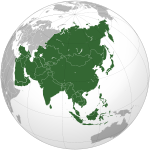
States with limited recognition - Dependencies and
- Special Administrative Regions
AustraliaPeople's Republic of ChinaUnited KingdomBrunei · East Timor · Indonesia · Malaysia · Philippines · Singapore · Papua New Guinea
Members of the Commonwealth of Nations Sovereign states - Antigua and Barbuda
- Australia
- Bahamas
- Bangladesh
- Barbados
- Belize
- Botswana
- Brunei
- Cameroon
- Canada
- Cyprus
- Dominica
- Fiji (suspended)
- The Gambia
- Ghana
- Grenada
- Guyana
- India
- Jamaica
- Kenya
- Kiribati
- Lesotho
- Malawi
- Malaysia
- Maldives
- Malta
- Mauritius
- Mozambique
- Namibia
- Nauru
- New Zealand
- Nigeria
- Pakistan
- Papua New Guinea
- Rwanda
- St. Kitts and Nevis
- St. Lucia
- St. Vincent and the Grenadines
- Samoa
- Seychelles
- Sierra Leone
- Singapore
- Solomon Islands
- South Africa
- Sri Lanka
- Swaziland
- Tanzania
- Tonga
- Trinidad and Tobago
- Tuvalu
- Uganda
- United Kingdom
- Vanuatu
- Zambia
Dependencies AustraliaNew ZealandUnited Kingdom- Akrotiri and Dhekelia
- Anguilla
- Bermuda
- British Antarctic Territory
- British Indian Ocean Territory
- British Virgin Islands
- Cayman Islands
- Falkland Islands
- Gibraltar
- Guernsey
- Isle of Man
- Jersey
- Montserrat
- Pitcairn Islands
- St. Helena, Ascension and Tristan da Cunha
- South Georgia and the South Sandwich Islands
- Turks and Caicos Islands
Monarchies List of current sovereign monarchs · List of current constituent monarchsBy continent By country Antigua and Barbuda · Australia · Andorra · The Bahamas · Bahrain · Barbados · Belize · Belgium · Bhutan · Brunei · Cambodia · Canada · Denmark · Grenada · Jamaica · Japan · Jordan · Kuwait · Liechtenstein · Lesotho · Luxembourg · Malaysia · Monaco · Morocco · Netherlands · New Zealand · Norway · Oman · Papua New Guinea · Qatar · Spain · Saint Kitts and Nevis · Saint Lucia · Saint Vincent and the Grenadines · Saudi Arabia · Solomon Islands · Swaziland · Sweden · Thailand · Tonga · Tuvalu · United Arab Emirates · United Kingdom · Vatican CityBy type Italics indicate Commonwealth realms, which each share the same person as head of state.International membership Association of Southeast Asian Nations Governance Member states Brunei · Burma (Myanmar) · Cambodia · Indonesia · Laos · Malaysia · Philippines · Singapore · Thailand · VietnamEnlargement Summits/Forums Related articles Anthem · Common Time · Date of Establishment · Emblem · Flag · Hymn · Organizations · SEA Games · Secretariat · Treaty of Amity and CooperationEast Asia Summit (EAS) First · Second · Third · Fourth · Fifth · SixthMembers of the Commonwealth of Nations Sovereign states - Antigua and Barbuda
- Australia
- Bahamas
- Bangladesh
- Barbados
- Belize
- Botswana
- Brunei
- Cameroon
- Canada
- Cyprus
- Dominica
- Fiji (suspended)
- The Gambia
- Ghana
- Grenada
- Guyana
- India
- Jamaica
- Kenya
- Kiribati
- Lesotho
- Malawi
- Malaysia
- Maldives
- Malta
- Mauritius
- Mozambique
- Namibia
- Nauru
- New Zealand
- Nigeria
- Pakistan
- Papua New Guinea
- Rwanda
- St. Kitts and Nevis
- St. Lucia
- St. Vincent and the Grenadines
- Samoa
- Seychelles
- Sierra Leone
- Singapore
- Solomon Islands
- South Africa
- Sri Lanka
- Swaziland
- Tanzania
- Tonga
- Trinidad and Tobago
- Tuvalu
- Uganda
- United Kingdom
- Vanuatu
- Zambia
Dependencies AustraliaNew ZealandUnited Kingdom- Akrotiri and Dhekelia
- Anguilla
- Bermuda
- British Antarctic Territory
- British Indian Ocean Territory
- British Virgin Islands
- Cayman Islands
- Falkland Islands
- Gibraltar
- Guernsey
- Isle of Man
- Jersey
- Montserrat
- Pitcairn Islands
- St. Helena, Ascension and Tristan da Cunha
- South Georgia and the South Sandwich Islands
- Turks and Caicos Islands
Nations in the Group of 15 (G-15) Asia-Pacific Economic Cooperation (APEC) Australia · Brunei Darussalam · Canada · Chile · People's Republic of China · Hong Kong · Indonesia · Japan · South Korea · Malaysia · Mexico · New Zealand · Papua New Guinea · Peru · Philippines · Russian Federation · Singapore · Chinese Taipei * · Thailand · United States · Vietnam
*Designation of the Republic of China (Taiwan)
Meetings Members and observers of the Non-Aligned Movement Members Afghanistan · Algeria · Angola · Antigua and Barbuda · Bahamas · Bahrain · Barbados · Belarus · Belize · Benin · Bhutan · Bolivia · Botswana · Brunei · Burkina Faso · Burma · Burundi · Cambodia · Cameroon · Cape Verde · Central African Republic · Chad · Chile · Colombia · Comoros · Congo · Côte d'Ivoire · Cuba · Democratic Republic of the Congo · Djibouti · Dominican Republic · Ecuador · Egypt · Equatorial Guinea · Eritrea · Ethiopia · Gabon · Gambia · Ghana · Grenada · Guatemala · Guinea · Guinea-Bissau · Guyana · Honduras · India · Iran · Jamaica · Jordan · Kenya · Kuwait · Laos · Lebanon · Lesotho · Liberia · Libya · Madagascar · Malawi · Maldives · Mali · Mauritania · Mauritius · Mongolia · Morocco · Mozambique · Namibia · Nepal · Nicaragua · Niger · Nigeria · Oman · Pakistan · Panama · Papua New Guinea · Peru · Philippines · Qatar · Rwanda · St. Lucia · St. Vincent and the Grenadines · São Tomé and Príncipe · Saudi Arabia · Senegal · Seychelles · Sierra Leone · Singapore · Somalia · South Africa · Sri Lanka · Sudan · Suriname · Swaziland · Syria · Tanzania · Thailand · East Timor · Togo · Trinidad and Tobago · Tunisia · Turkmenistan · Uganda · United Arab Emirates · Uzbekistan · Vanuatu · Venezuela · Vietnam · Yemen · Zambia · ZimbabweObservers Countries Antigua and Barbuda · Armenia · Azerbaijan · Bosnia-Herzegovina · Brazil · China · Costa Rica · Croatia · Cyprus · Dominica · El Salvador · Kazakhstan · Kyrgyzstan · Mexico · Montenegro · Russia · Serbia · Ukraine · UruguayOrganizations Organisation of Islamic Cooperation (OIC) Members Afghanistan · Albania · Algeria · Azerbaijan · Bahrain · Bangladesh · Benin · Burkina Faso · Brunei · Cameroon · Chad · Comoros · Côte d'Ivoire · Djibouti · Egypt · Gabon · Gambia · Guinea · Guinea-Bissau · Guyana · Indonesia · Iran · Iraq · Jordan · Kuwait · Kazakhstan · Kyrgyzstan · Lebanon · Libya · Maldives · Malaysia · Mali · Mauritania · Morocco · Mozambique · Niger · Nigeria · Oman · Pakistan · Palestine · Qatar · Saudi Arabia · Senegal · Sierra Leone · Somalia · Sudan · Suriname · Syria · Tajikistan · Turkey · Tunisia · Togo · Turkmenistan · Uganda · Uzbekistan · United Arab Emirates · YemenObservers Countries and territoriesBosnia and Herzegovina · Central African Republic · Russia · Thailand · Northern Cyprus (as Turkish Cypriot State)Muslim communitiesInternational organizationsLanguages Austronesian-speaking countries and territories Formosan Malayo-Polynesian American Samoa · Brunei · Burma (Myanmar) · Cambodia · Christmas Island · Cocos (Keeling) Islands · Cook Islands · Easter Island · East Timor · Fiji · French Polynesia · Guam · Hainan · Indonesia · Kiribati · Madagascar · Malaysia · Marshall Islands · FS Micronesia · Nauru · New Caledonia · New Zealand · Niue · Northern Mariana Islands · Orchid Island · Palau · Papua New Guinea · Philippines · Samoa · Singapore · Solomon Islands · Sri Lanka · Suriname · Tokelau · Tonga · Tuvalu · United States (Hawaii) · Vanuatu · Vietnam · Wallis and FutunaChinese-speaking nations and regions English-speaking world Countries and territories where English is the national language or the native language of the majority.
Africa Americas Anguilla · Antigua and Barbuda · The Bahamas · Barbados · Bermuda · British Virgin Islands · Canada · Cayman Islands · Dominica · Falkland Islands · Grenada · Guyana · Jamaica · Montserrat · Saba · Saint Kitts and Nevis · Saint Lucia · Saint Vincent and the Grenadines · Sint Eustatius · Sint Maarten · South Georgia and the South Sandwich Islands · Trinidad and Tobago · Turks and Caicos Islands · United States · United States Virgin IslandsEurope Oceania Countries and territories where English is an official language, but not the majority language.
Africa Americas Asia Europe Oceania American Samoa · Christmas Island · Cocos (Keeling) Islands · Cook Islands · Fiji · Guam · Kiribati · Marshall Islands · Micronesia · Nauru · Niue · Northern Mariana Islands · Palau · Papua New Guinea · Pitcairn Islands · Samoa · Solomon Islands · Tokelau · Tuvalu · VanuatuCategories:- Malaysia
- Southeast Asian countries
- Countries of the Indian Ocean
- Countries bordering the South China Sea
- Member states of the Association of Southeast Asian Nations
- Chinese-speaking countries and territories
- English-speaking countries and territories
- Malay-speaking countries and territories
- Former British colonies
- Member states of the Organisation of Islamic Cooperation
- Constitutional monarchies
- Developing 8 Countries member states
- Federal countries
- G15 nations
- World War II sites
- Member states of the Commonwealth of Nations
- States and territories established in 1963
- Member states of the United Nations
- Outline of Malaysia
Wikimedia Foundation. 2010.

